





60 YEARS.
The BC2100XL is a standout in our wood chipper range. With a full function remote control, and offset horizontal feed roller, disposing of tree materials has never been safer. Plus, you’ll be backed by the service and support of Australia’s largest tree care equipment dealer network. Contact your local Vermeer Australia team to try it for yourself.

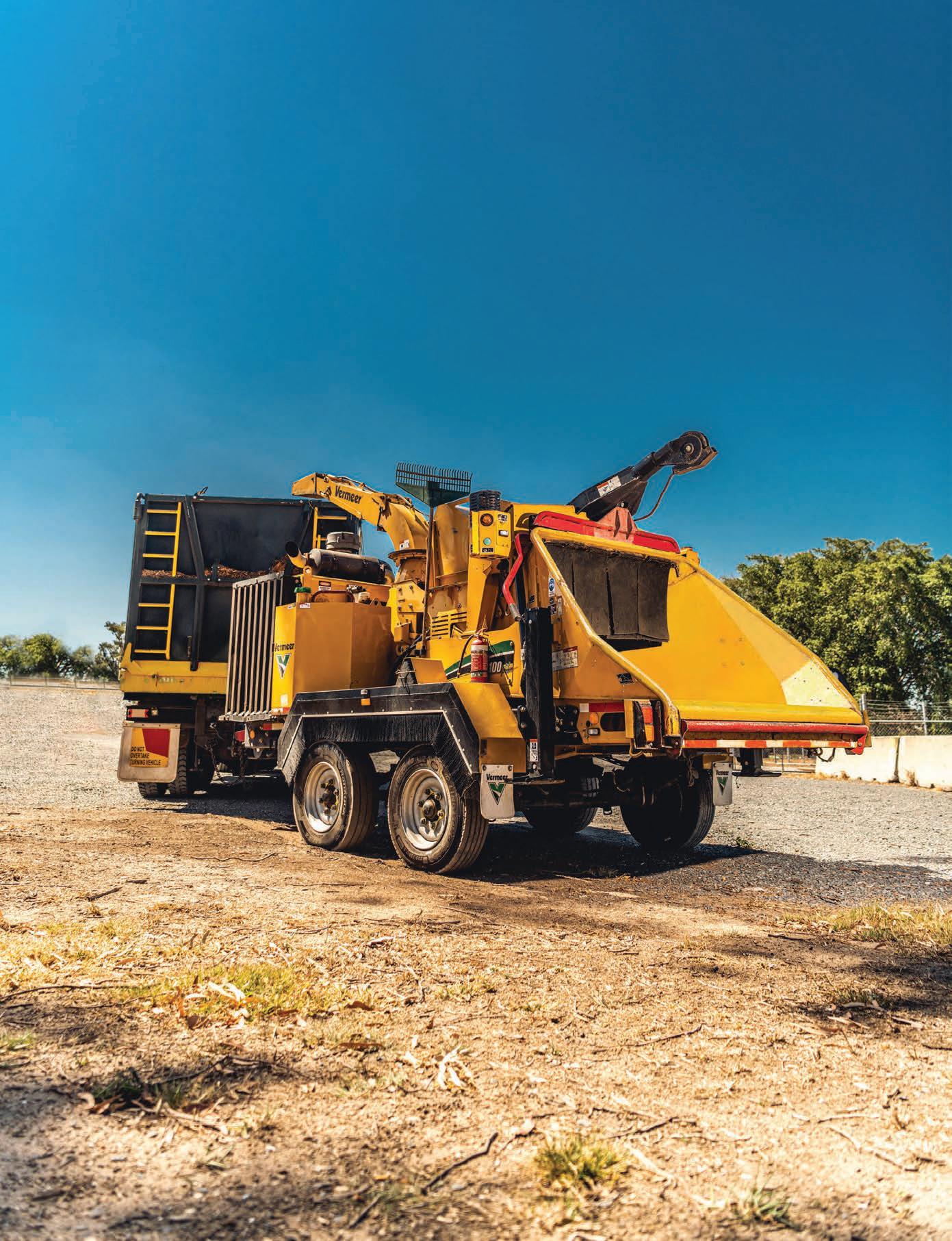
 VERMEER AUSTRALIA HAS BEEN AT THE FOREFRONT OF INNOVATIVE SAFETY AND PERFORMANCE FEATURES IN OUR TREE CARE RANGE FOR MORE THAN
VERMEERAUSTRALIA.COM.AU | 1300 VERMEER
Vermeer and the Vermeer logo are trademarks of Vermeer Manufacturing Company in the United States and /or other countries. Product specifications are subject to change by OEM. © 2023 RDO Equipment Pty Ltd (trading as Vermeer Australia). All Rights Reserved.
VERMEER AUSTRALIA HAS BEEN AT THE FOREFRONT OF INNOVATIVE SAFETY AND PERFORMANCE FEATURES IN OUR TREE CARE RANGE FOR MORE THAN
VERMEERAUSTRALIA.COM.AU | 1300 VERMEER
Vermeer and the Vermeer logo are trademarks of Vermeer Manufacturing Company in the United States and /or other countries. Product specifications are subject to change by OEM. © 2023 RDO Equipment Pty Ltd (trading as Vermeer Australia). All Rights Reserved.
Here we are facing the change of seasons and, if you’re like me, wondering if you somehow blinked and missed Summer and the holiday break.
Seriously, I was running flat stick until the Christmas shutdown, and by the time I’d mowed the yard a few times and sat through a few episodes of Bluey with the granddaughters, it felt as though I was back at my desk again and up to my eyes in work.
Still, here we are, and things are really looking pretty good. If The Australian Arbor Age is the voice of Australian arboriculture, that voice is delivered in the annular-ringing tones of a Pavarotti or Domingo. Or maybe the bark of Busker from Bluey. Like bad puns, it’s hard to get those things out of your head once they get in there.
In any case, Cassian Humphreys has continued to develop his new, sharper style of writing, and it’s kicking big goals for mine. He’s a bloke with some seriously high-level technical knowledge, and I’m enjoying being able to quickly grasp his ideas and lofty aims. Jim McArdle is another pro with a far-reaching vision for the future of the Australian arbor industry, and he’s put together an excellent summation on eco-arborists and some of the possibilities the idea has for Australian arboriculture. I recommend the read as a well-thought-out line of study with a very practical and advantageous outcome.
Elsewhere in the mag, the associations have lobbed in updates on their activities all around The Wide
Brown Land, and of course we have some fantastic new equipment, great advice from experts in related industries, and a few good stories that should give a smile and a break from the rough and tumble of day-to-day work.


My eye is constantly drawn to the Bandit story on page 56.
Maybe I had more time with the granddaughters than I realised. When my first thought is that Bandit is another character from Bluey, it’s probably high time I got back to work.
Enjoy the mag…and Bluey if you get the chance to watch a few episodes.
Warm regards, Tom Foster – Editor

The Australian Arbor Age is published bimonthly by Prime Creative Media Pty Ltd.


CEO John Murphy
COO Christine Clancy Sales Director
Bradley Buchanan
National Advertising Manager
Sue Janjic suzana.janjic@primecreative.com.au Mob. 0419 531 401
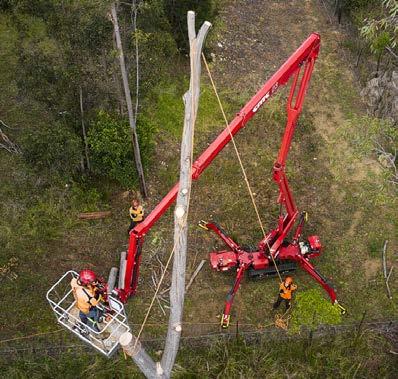
Art director/design
Daz Woolley
Subscriptions
P. +61 3 9690 8766 subscriptions@primecreative.com.au Website www.arborage.com.au
The Australian Arbor Age magazine is owned by Prime Creative Media and published by John Murphy. All material in The Australian Arbor Age magazine is copyright and no part may be reproduced or copied in any form or by any means (graphic, electronic or mechanical, including information and retrieval systems) without written permission of the publisher. The editor welcomes contributions but reserves the right to accept or reject any material. While every effort has been made to ensure the accuracy of information, Prime Creative Media will not accept responsibility for errors or omissions, or for any consequences arising from reliance on information published.
The opinions expressed in Arbor Age magazine are not necessarily the opinions of, or endorsed by, the publisher unless otherwise stated.
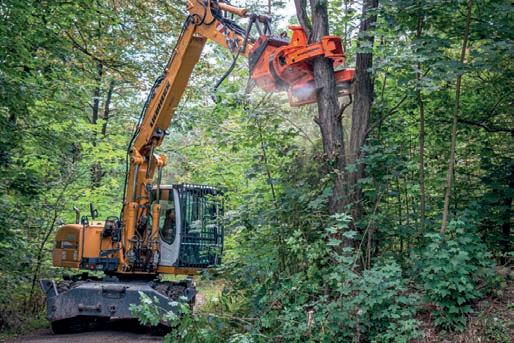
© Copyright Prime Creative Media, 2023
Articles
All articles submitted for publication become the property of the publisher. The editor reserves the right to adjust any article to conform with the magazine format.
Head Office
379 Docklands Dr, Docklands VIC 3008
P: +61 3 9690 8766

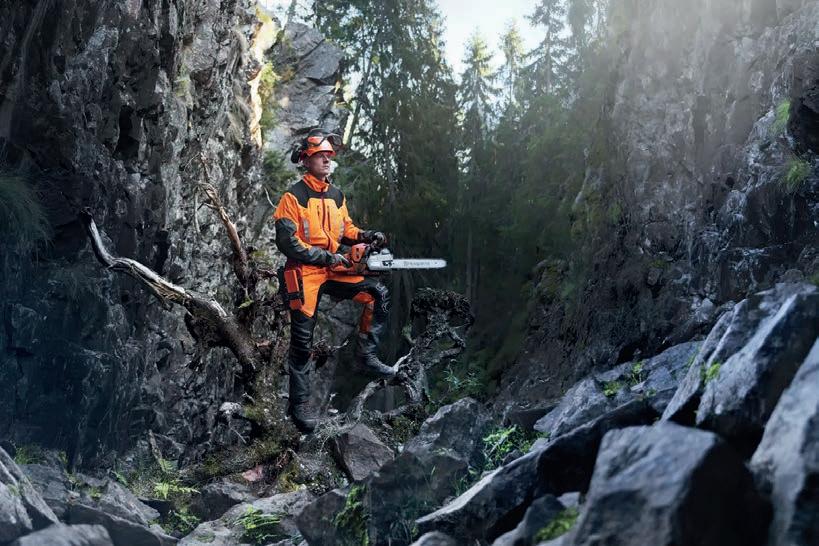
enquiries@primecreative.com.au www.primecreative.com.au
Sydney Office Suite 3.06, 1-9 Chandos Street Saint Leonards NSW 2065, Australia P: +61 2 9439 7227
An experienced tree climber, instructor, rboriculturist, consultant, educator and writer, he has 30 years of experience. He sees his work as making a contribution to the Australian arboricultural profession.


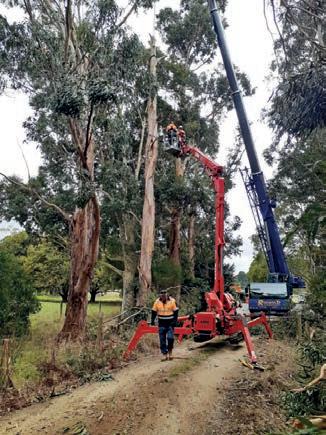




Co-founded by Planet Ark and Olivia Newton-John in 1996, National Tree Day has grown to where this year the aim is to plant one million new trees in Australia.

National Tree Day is a call-to-action for Australians to unite and give back to the community and the land on which they live, and so far nearly 26-million trees have been planted by around five-million people in aid of the event.


It’s an excellent opportunity to head outdoors and learn about your community while having fun improving the environment. National Tree Day is a great day to lead an assembly about the importance of trees and how they help to keep our environment and atmosphere safe for us to live in.
Discussion on National Tree Day could be around how trees function as an important habitat for lots of different types of wildlife, and looking into the different types of trees that can be found around the world can be a nice lead in to a topic on different environmental habitats. You can also look at how trees provide a source of food for many animals, a good introduction to the topic of biodiversity.



CMC Aerial Platforms offer a range of compact and highly manoeuvrable spider lifts with market-leading reach.

The CMC spider lifts Global Machinery Sales stock for the Australian market range from 13 metres in height through to 32 metres, and each lift has an impressive outreach, powerful engine and large basket capacity.
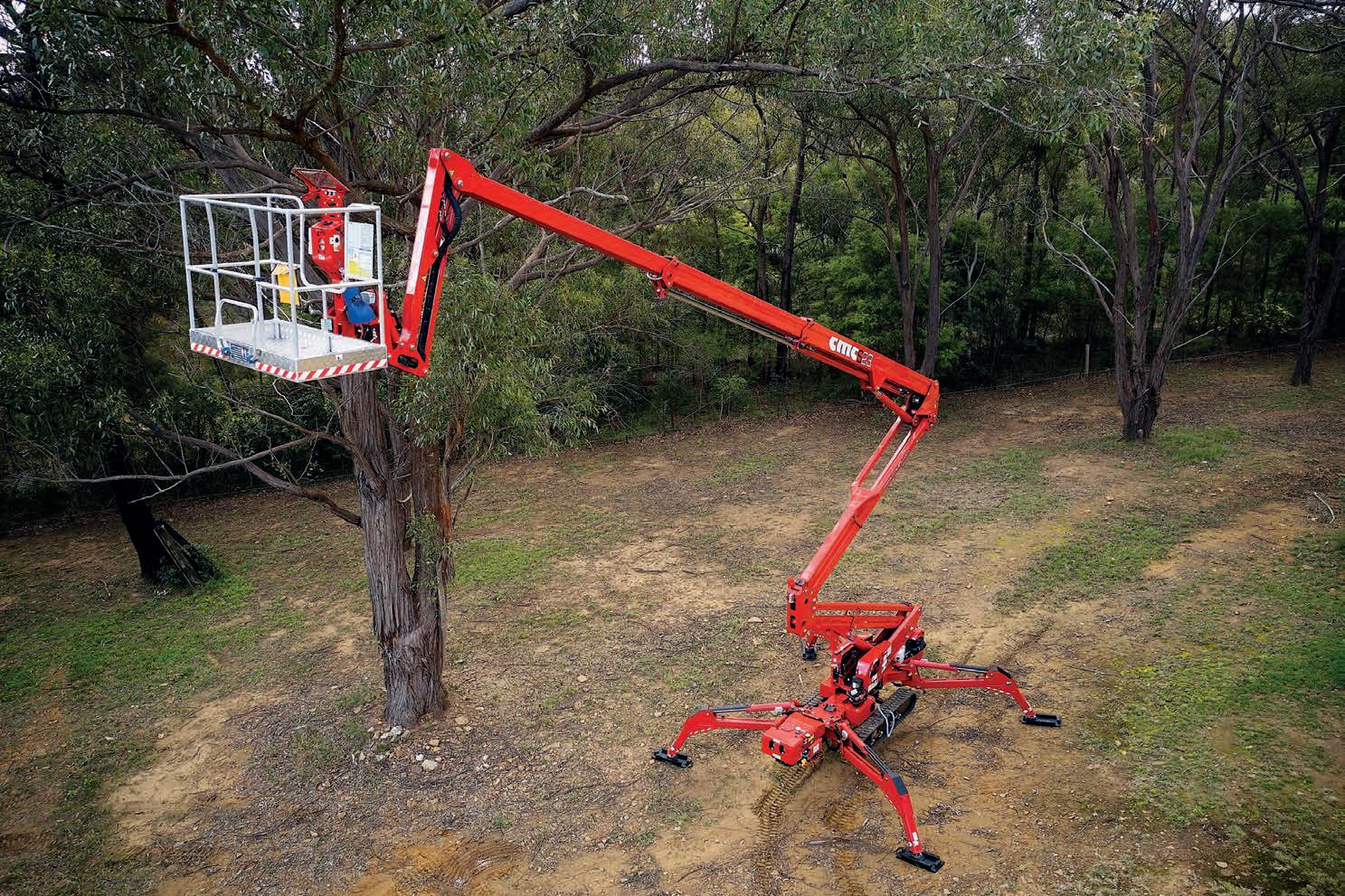
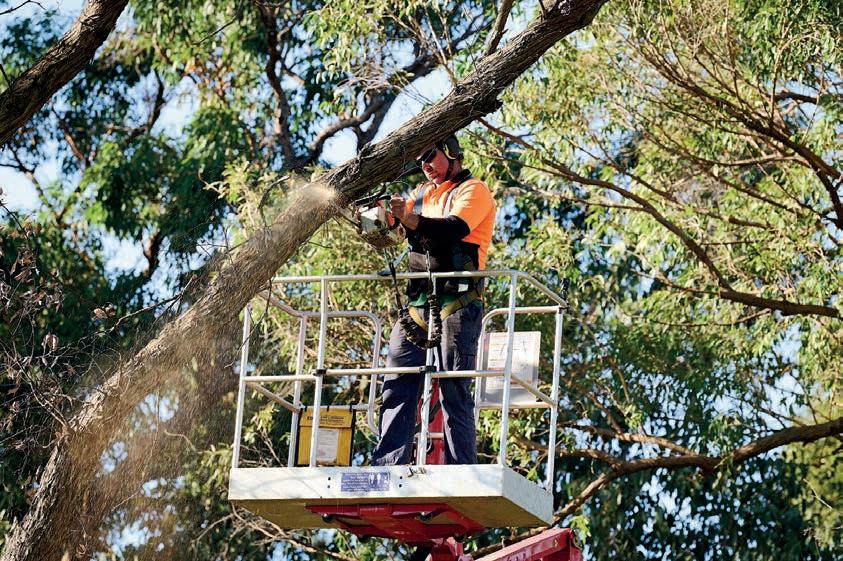
Global Machinery Sales has worked diligently with top EWP dealers in America and Europe to bring you the world-renowned leader.
Here are four of the best-selling CMC spider lifts from the huge range Global Machinery Sales currently has in stock and ready to get to work. Get in touch with Global Machinery Sales to take advantage of the instant asset write off which looks like finishing in June this year while GNS still has stock.
CMC 18F
The CMC S18F 17.7m spider lift’s simplicity is its greatest strength, making it easy for operators of all skill levels to use. The full hydraulic design, complete with a pantograph and two telescopic boom extensions, plus an articulating jib, makes this lift incredibly versatile and able to tackle a wide range of tasks.
One of the key selling points of the S18F is its portability. At only 2390kg, it can be easily towed on a trailer, making it a great addition to any equipment fleet. This makes it perfect
for contractors who need to move frequently from job site to job site.
which is known for its innovation and cutting-edge technology. The S18F stands out thanks to its combination of power and ease of use.
is an excellent choice for anyone in need of a reliable and user-friendly aerial lift. Its portability and versatility make it a valuable asset for any company, and its simplicity ensures it will be a favorite among operators.

CMC Spider Lifts have been taking the Australian market by storm. All models are Australian Design Verified and ready to go to work.
The CMC S23 23m spider lift is a compact aerial lift that packs a punch when it comes to performance. This lift boasts a double pantograph platform with articulated arms and jib, making it a formidable piece of equipment.
This lift is fast becoming an arborist favorite in Australia



The S23 is the result of CMC’s 20+ years of experience in the industry, and it shows in the lift’s design. The geometric platform is cutting-edge and incorporates high-quality steels, making it lightweight at just 2984kg. This allows for easy transportation on a trailer, increasing its versatility and possibilities for use.
The S23 has impressive specs, with a maximum working height of 23 metres and a maximum outreach of 12.4 metres. The basket is spacious, measuring 1.4 x 0.7 x 1.1 metres, and has a maximum load capacity of 200kg. The lift’s turret rotation is +/- 355° (710° continuous), and the basket rotation is +90/-87° (optional).
Overall, the CMC S23 23m spider lift is a powerful, compact, and versatile option for those in need of an aerial lift. Its compact size and ease of transportation make it a great option for contractors who need to move frequently from job site to job site. The lift’s impressive specs and CMC’s 20 years of experience make it a valuable asset for any company.
The compact size and ease of transportation make the CMC 23 a great option for contractors who need to move frequently.
The CMC S25 25m spider lift is a reliable and feature-rich aerial lift that is sure to impress. With a working height of 25 metres and an impressive 14-metre outreach, this lift is capable of tackling even the most challenging tasks.


The S25 is a self-propelled, tracked, aerial platform, designed with one articulating/one telescopic lower boom and one articulating/two telescopic upper booms, plus an articulating jib on the end. This combination allows for unparalleled manoeuvrability and outreach, making it a pleasure to work with. It has a quick-release, 180° rotating basket with triple safety locks. Standard basket size is 1.70m wide, but other smaller basket sizes are also
available to best fit your application. The S25 comes equipped with many exceptional time-saving features, such as two stabilisation areas and six possible outrigger configurations. With incredibly compact dimensions of 1.01m x 2.045m x 6.05m (WxHxL) in the closed travel position, this serious aerial work platform is capable of entering virtually any door. It comes standard with a quiet diesel engine/240v electric hydraulic power pack, and is also available with a hybrid power source. It takes the place of the best-seller S24, improving its performance and reliability!
In terms of specs, the S25 has a maximum working height of 25m and maximum working outreach of 14m
with 80kg load. It has a max basket capacity of 230kg, jib movement of 90°, turret rotation of +/-360°, and basket rotation of +/-90°. It also has a maximum slope to stabilize of 15°/27%, height/width tracks adjustment of 0.18m, max angle approach of 14°/25%, max travel slope of 19°/34%, and max travel speed of 1.5kmph.
Overall, the CMC S25 25m spider lift is an exceptional aerial lift packed with features to make work easier and more efficient. Its impressive specs and time-saving features make it a valuable asset for any company, and its compact size and versatility make it perfect for contractors who need to move frequently from job site to job site.
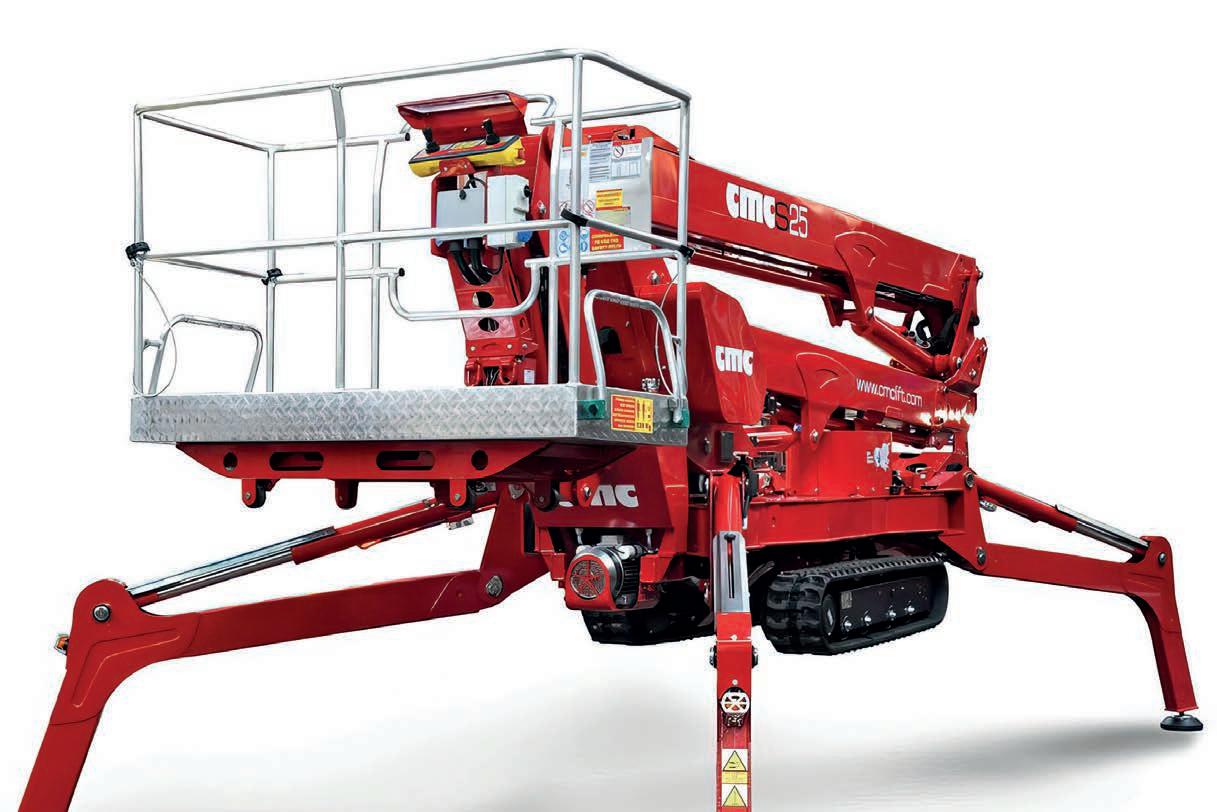
The CMC S28 28m spider lift is a true powerhouse in the world of aerial equipment. When the going gets tough, this lift is able to handle whatever challenges come its way. Its unparalleled performance and advanced technology make it an unstoppable platform that is unrivaled in the industry.
The S28 is built with high-performance materials, making it able to work almost anywhere. Its intuitive operating system and unparalleled manoeuvrability make it an extremely versatile platform that can overcome any obstacle. The indication of the error code and a quick and easy operation make it a must-have in any fleet. The performance of the stabilisers even allows it to be self-loaded on a truck.
The S28 has impressive specs, including a maximum working height of 28 metres, a maximum working underground of -6.7 metres, and a maximum outreach of 14 metres. The basket is spacious, measuring 1.7 x 0.7 x 1.1 metres, and has a maximum load capacity of 230kg. The lift’s turret rotation is +/-200° (400° continuous), and the basket rotation is +/- 90°. The lift weighs in at 4175kg.
In conclusion, the CMC S28 28m spider lift is a top-of-the-line aerial lift built to handle the toughest jobs. Its advanced technology, unparalleled performance,

 An intuitive operating system and unparalleled manoeuvrability make the CMC 28 an extremely versatile platform.
An intuitive operating system and unparalleled manoeuvrability make the CMC 28 an extremely versatile platform.
The NSW Department of Planning and Environment has come up with a new app called The Trees Near Me NSW.
Built for landholders, conservationists, land managers and anyone with an interest in NSW flora, the Trees Near Me NSW app provides a simple-to-use way to learn about which plants are growing anywhere in the Premier State, including native-plant communities such as State Forests, National Parks and areas of bushland still present throughout NSW. The app also has a function which shows what the plant communities looked like before areas were cleared.
The app includes:
• Learning more about vegetation in a particular locality and throughout NSW. The vegetation map shown in the app is the well-known NSW State Vegetation Type map
• Listings of native Plant Community Types (PCT) and species within selectable areas
• A search of native vegetation information within a search area
of 200 metres, 400 metres or 1000 metres
• A focus on individual species
• A link to search for pictures and descriptions of specific plants and links for more information, and
The Queensland Arboricultrual Association (QAA) is on a charge to support Rod Morris from the Queensland Farmers Federation. Rod is currently investigating the skills gap in the arborist industry and looking to determine if improving the delivery method and funding for education courses will reduce, or even remove, the industry skills gap.
To ensure both viewpoints are covered, there are different surveys for
students and employers with all data submitted being anonymous.
The QAA knows the issue of a skills gap has become increasingly prevalent in recent years and is happy to be able to support the improvement of
• Descriptions of vegetation for areas which have since been cleared and populated.
The app is especially useful for landscapers working in close proximity to sensitive areas, and to help in advising clients in their selection of species. It’s also an excellent way to quickly get an overview of PCTs for any area of NSW where proposals and quotes are being prepared.

Trees Near Me is available from both the Apple app store and Google Play, or visit treesnearme.app.

arborist education in Queensland while maintaining an independent industry position. As a not-for-profit, incorporated association representing arborists in Queensland and northern New South Wales, QAA’s mission is to provide support and guidance to the arborist industry and its members.

To complete either the student or employer survey, log on to qaa.net.au and follow the prompts.

The National Trusts of Australia are community-based, non-government organisations, committed to promoting and conserving Australia’s indigenous, natural and historic heritage through advocacy work and custodianship of heritage places and objects.
The National Trusts of Australia are collaborating to create a national register of significant trees, consistent with the mission to protect and celebrate Australia’s heritage.
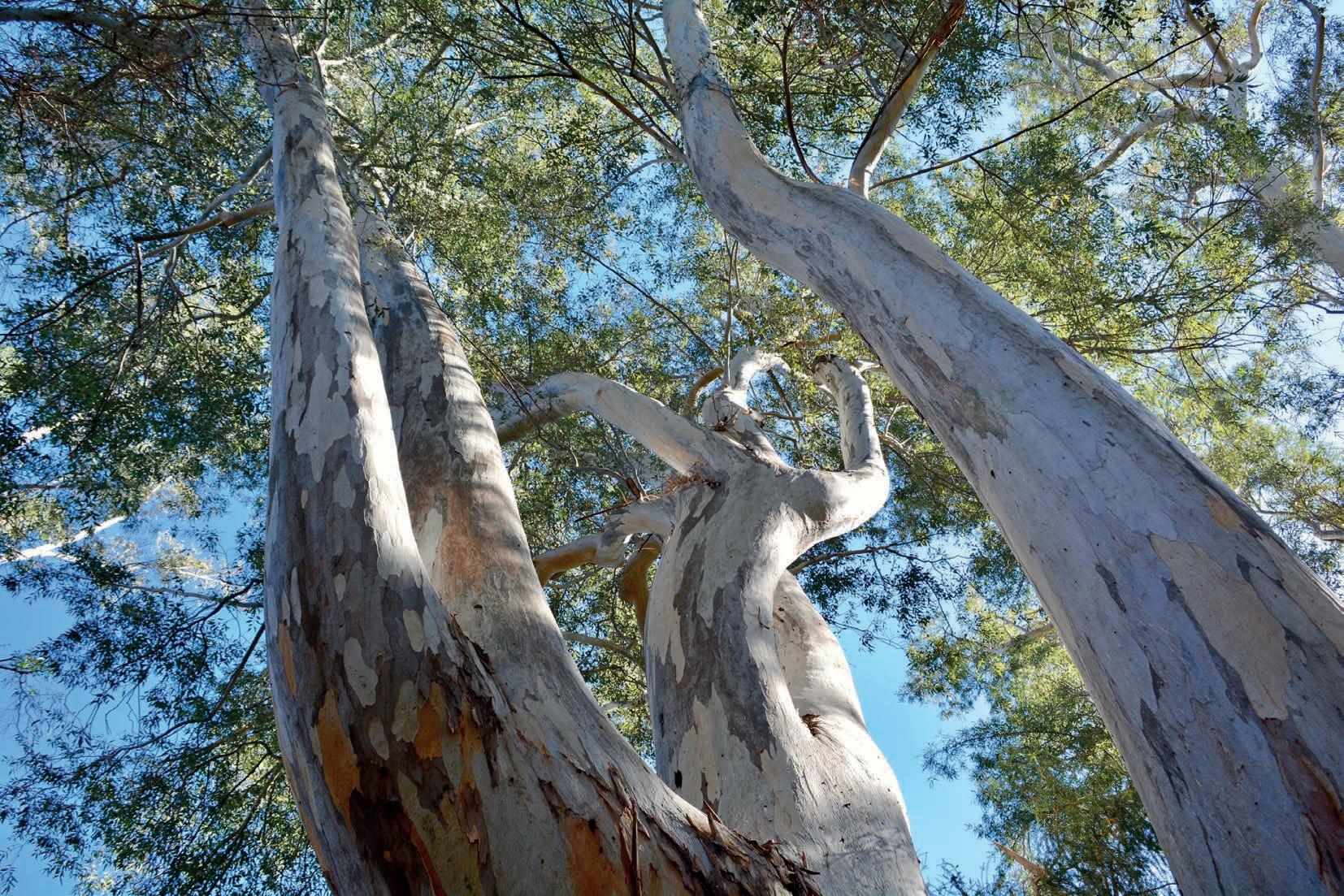
There are over 2500 significant tree
records compiled over 30 years by the National Trusts across Australia. These records are continually updated by volunteers and loaded into the National Register.
The Register of Significant Trees is not a static list of specimens. It’s constantly evolving as some trees die or require removal, and new trees are registered. New trees may be nominated by any individual or group by completing an online nomination form.
New trees are assessed against
nationally agreed criteria by the Significant Trees Committees for each state or territory. Information and observations from interested individuals and arbor professionals helps improve and update the Register, so please help by submitting your nomination, helping the register advocate for the protection and celebration of Australia’s significant adn magnificent trees.
Find out more and download a nomination form at trusttrees.org.au.
‘Nature positive’ is a helpful concept signalling a global appetite to recognise the true value of nature and rebuild it in ways that benefit communities, economies and the environment.
Constructive early steps and commitments have been made towards a nature-positive future both globally and here in Australia.
The Australian Government had already committed to 30×30 in 2021 – that is, to protect 30 percent of the nation’s lands and waters by 2030 – and reaffirmed this commitment in 2022 under new leadership.
At the same time, the Australian Government announced an additional target of zero new extinctions (a goal over and above those later agreed in the Kunming-Montreal Global Biodiversity Framework). Just prior to COP15, the Australian Government announced its Nature Positive Plan in response to a review of the EPBC Act. As well as the

30×30 commitment, the plan also looks to introduce national environmental standards and establish an Environmental Protection Agency with enforcement powers. This legislation is set to be introduced to parliament before the end of 2023.
Now, as a signatory to the COP15 framework, Australia has committed to delivering the package of measures it outlines – including the new goal for 30 percent of areas of degraded ecosystems to be under effective restoration by 2030.
The ABC has run a poll to discover Australia’s most popular tree, and the winner has been found.
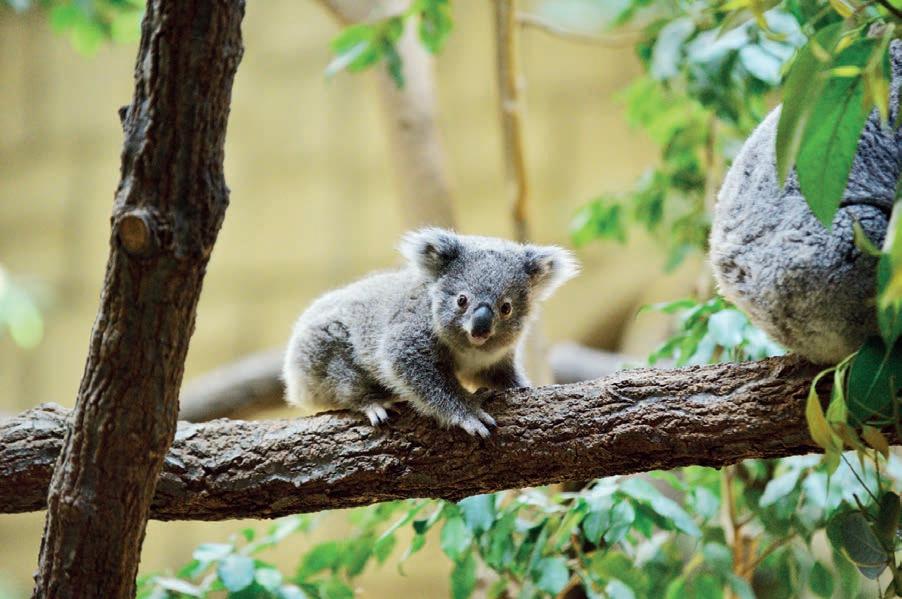
Kicking off with 33 possibilities, a panel of experts and, believe it or not, gathering a staggering 80,000 votes, the list was first trimmed to 10. The finalists were:
• Boab (Adansonia gregorii )
• Ghost Gum (Corymbia aparrerinja)
• Golden Wattle (Acacia pycnantha)
• Illawarra Flame Tree (Brachychiton acerifolius)
• Karri (Eucalyptus diversicolor)
• Moreton Bay Fig (Ficus macrophylla)
• Mountain Ash (Eucalyptus regnans)
• Red Flowering Gum (Corymbia ficifolia)
• River Red Gum (Eucalyptus camaldulensis), and

• Snow Gum (Eucalyptus pauciflora).
At the end of a long process, the mighty River Red Gum trumped the field and now rules as the people’s choice.
The Albanese Government has welcomed the final report of the Independent Review of Australian Carbon Credit Units (ACCUs) to ensure confidence in the integrity and effectiveness of the ACCU scheme.
The Review concludes the ACCU scheme arrangements are sound, but recommends that, after 11 years of operation, some sensible changes will strengthen the scheme.
Recommended updates include clarifying governance, improving transparency, and facilitating positive project outcomes and co-benefits.
The Government has accepted in principle all 16 recommendations of the independent panel, led by former Chief Scientist Professor Ian Chubb AC.
The Government commissioned the Review in July 2022 to explore how the scheme can best support Australia’s emission reduction targets, support cultural, social, economic and
environmental outcomes, and address concerns raised about the scheme’s level of integrity.
The Independent Panel reviewed the scheme’s architecture and governance, and the broader impacts of carbon projects, including for agriculture, biodiversity, participation of First Nations peoples and regional communities.

A strengthened scheme will also provide increased opportunities for farmers, the agricultural sector and other participants in the carbon market.
The Panel consulted widely with industry experts, Federal, State and Territory governments, regional councils, First Nations and Native Title representative groups, carbon service providers and current and former administrators, reviewing over 200 submissions.
The recommended improvements ask the Government to:
• Clarify the intention of the scheme
• Clearly identify and separate the key roles of integrity assurance, regulation and administration
• Improve transparency and remove unnecessary restrictions on data sharing
• Provide more support for regional communities and First Nations peoples to participate in and benefit from the scheme, and
• Improve information and incentives, including in relation to non-carbon benefits and attributes.
The Government recognises the panel’s recommendations have implications for a wide range of market participants and other stakeholders, and will work with them on implementation, including any associated legislative amendments.
Importantly, the Government will ensure alignment with its new Nature Repair Market and ensure programs such as Climate Active are best practice in consultation with stakeholders.
Conservation arboriculture for land care.
Welcome to the new year!
I’m always being drawn to ideas to help sell arboriculture, in concept as well as in service. I’m working on a brochure for homeowners and private land custodians, as I recognise that many top end projects are grass roots. I recognise many homeowners have a great love of their gardens and take great pride in caring for their properties. Winning these kinds of clients leads to top-end work and great repeat business. In this issue I’m writing for those who seek resilience, sustainability, or sovereignty on their own turf.
What is arboriculture?

‘Arbor’ is Latin for tree,and involves the culture of trees. ‘Arborist’ – a shortened version of ‘arboriculturist’ – is a term that best defines the industryled practitioners and enthusiasts, as opposed to the professional, or those who call themselves arboriculturists. Most arborists prune, lop (look at Wikipedia’s definition), fell, and process trees into mulch, and this is contrary to the intention/meaning of ‘arboriculture’. The profession is driven by an industry prerogative which is more about tree removal, machinery sales, economics, and compliance than it is tree care. The top end 5-10% of the arboricultural profession is science-focussed and very passionate about tree retention and care.
So why conservation arboriculture?
Conservation we are largely familiar with. This series is being developed in support of tree-custodians – that’s tree/homeowners and professionals alike. Or, those individuals who can discern for themselves (with only a gentle nudge), the silent lore of nature and natural systems. I believe many land custodians have the capacity for great conservation arboriculture with
A veteranised ancient Marri Gum – Corymbia calophylla – located on the Brockman Highway WA, heading to Augusta, with a 2.2m stem diameter. I’d suggest this tree is at the end of the second third of its lifespan, roughly 180 years old. It would’ve been seedling in or around 1840. It’s a living monument to our Aussie past. The wildlife habitat provided by trees like this cannot be replicated by humanity, but can be easily supported by us via proactive tree care.





A Bridgetown veteranised ancient Jarrah Gum – Eucalyptus marginata. this tree is an Alpha which has had its crown naturally supressed by nature. This tree looks like it’s been lopped, but not so. The taper from the trunk to outer canopy is true, the only wounding in this tree is from dieback.


only a little good education. In the previous issue I introduced the term ‘naturaculture’, arboriculture aligned with nature intelligence. Not everyone gets arboriculture, but deep down we all get naturaculture – the culture of nature is at the seat of our consciousness, biology, and part of our DNA.
The way we care for gardens, our bodies, diet, health, animals, and the land is personal. For those of us switched on by nature, we need to see and understand her graces for ourselves, as opposed to being told. Impacts on our, and nature’s, resilience are the norm. We only need to look at tree longevity to see this. With our current lifestyles, we all support reduced tree-life expectancy in the order of decades. Most urban and rural trees currently live only a third of their actual lifespans. Imagine if we humans all died at ages 25-30?
This issue also impacts on the wildlife dependent on habitat hollows in trees. The significant lack of old-age class trees is a reflection on just how much forest clearing historically occurred Downunder.
Conservation arboriculture is being born out of the tree-care movement.
In the face of climate change I see this as the next level in resilient towns and cities, with the targeted 60 per cent minimum for green city or town cover to achieve sustainability.
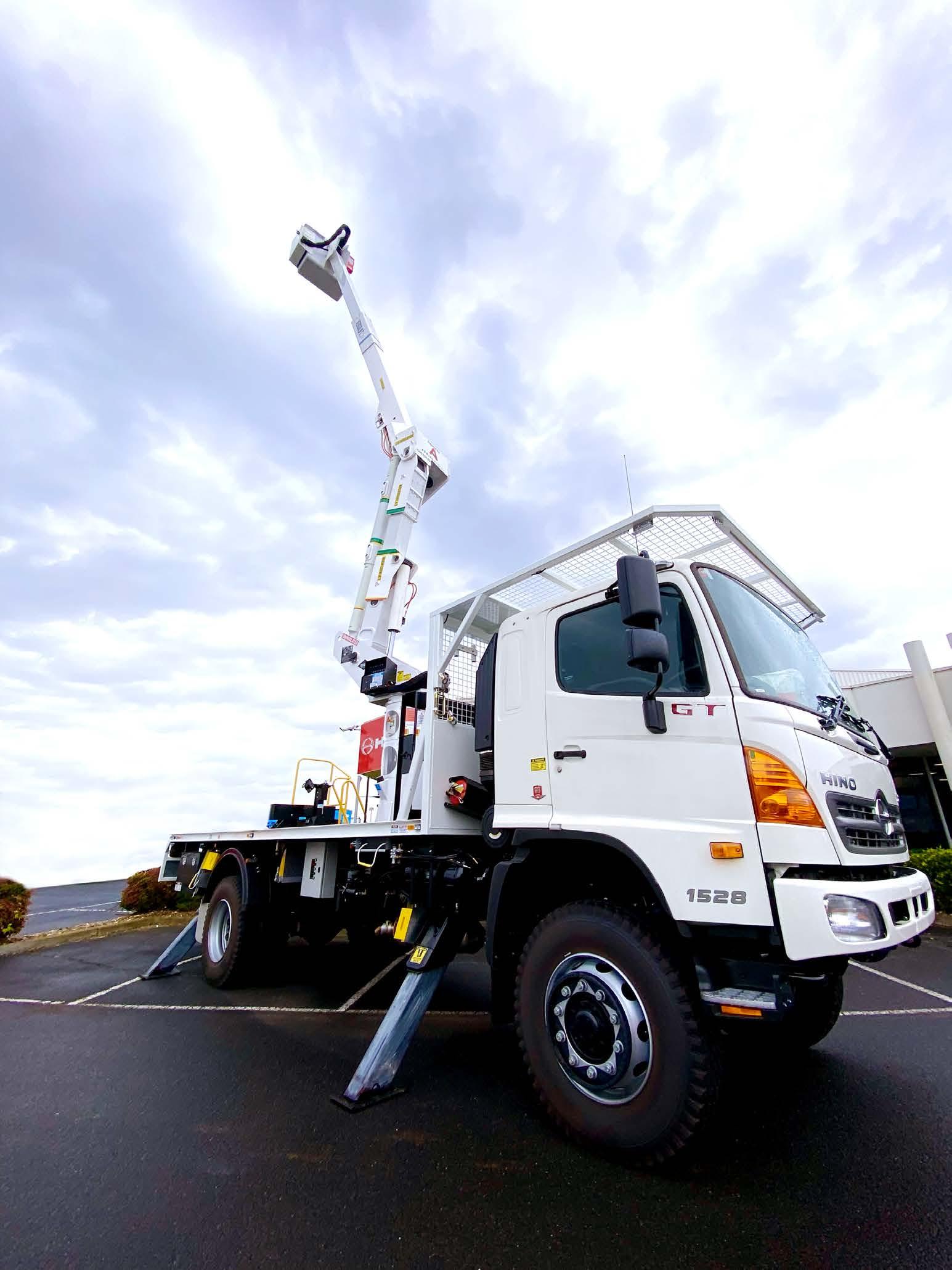
Here are some arboricultural tree terms with explanations:
• Ancient – a tree in the prime of its life, usually in the last one-third of its lifespan.
• Veteran – a tree of any age which has had its body impacted by an event (ie
storm damage or development). An ancient tree can also be a veteran.
• Alpha – Latin for ‘number one’, this is a tree which has been trained for resilience and longevity. The 1 in 10,000 trees, alphas may be reflective of a species, a genus (group of species) or an individual specimen. This is a natural phenomenon caused by the pruning of terminal buds. In nature and cities this is created by wind, frost, drought, wildlife, bus pruning (caused by repetitious bud-strike on trees overhanging bus lanes), and arboriculturists. We humans can help train trees to stand up to storm events and to be naturally resilient.
‘Stormproofing’ is a term I love to use, though in nature there are no absolutes. Yet alpha-trained trees perform far better than their wild-forest cousins when it comes to storm events.


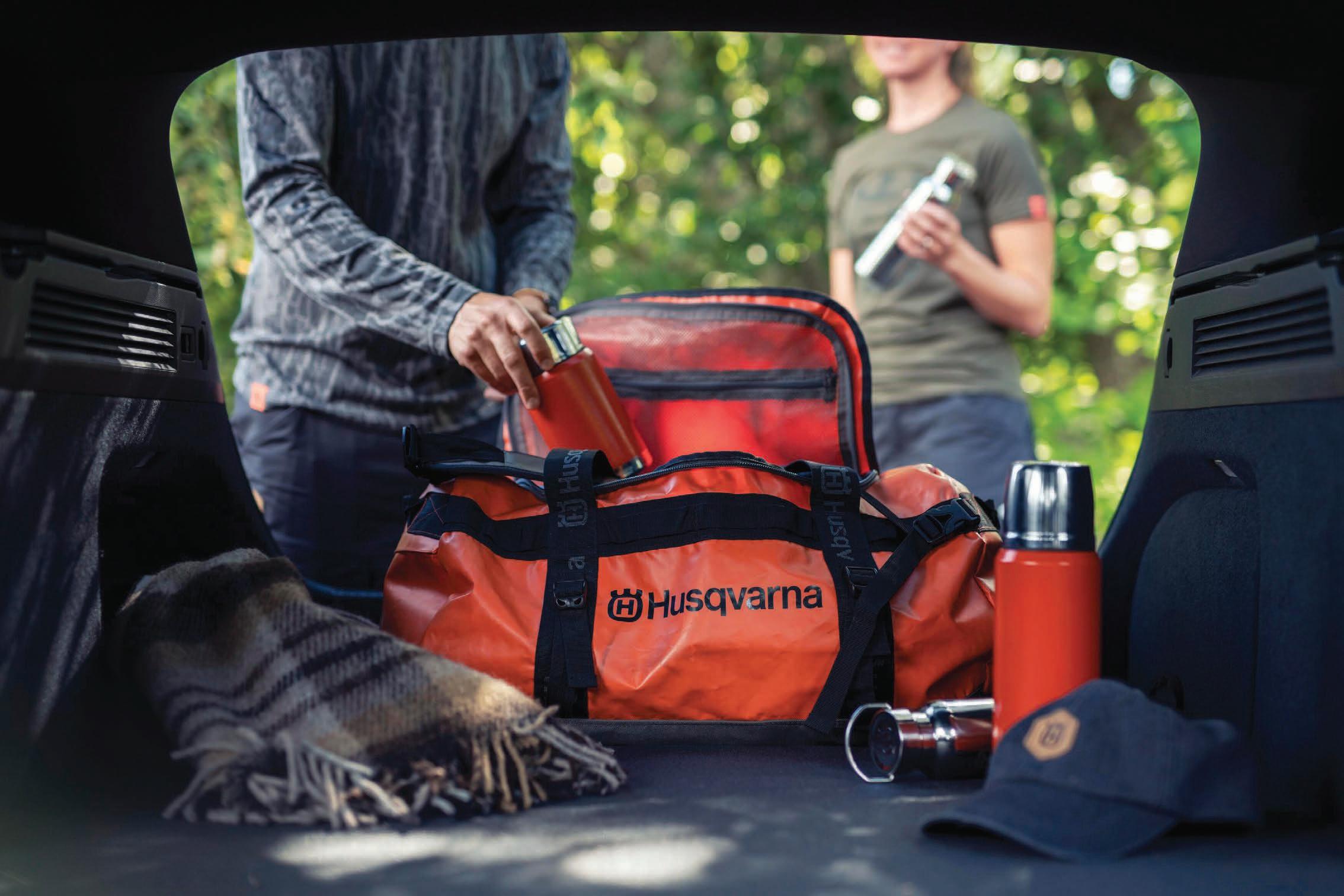
Optimum taper, squatness, and structure in the tree’s upper crown.


Show who you are, even if you’re not doing any tough work at the moment. The Husqvarna Xplorer range of products and leisure wear are designed to always keep you comfortable and confident, whether you want to relax or explore, at home or outdoors. Husqvarna makes it better.
Explore the complete collection at HUSQVARNA.COM
With over 333 years of innovation and passion, Husqvarna provides professionals with forest, park and garden products. We let high performance meet usability and safety, making you ready to get the job done efficiently.

The above images are before (left) and after (right) a preliminary prune on a Marri Gum. The prune was to reduce elongation and set up the branch for subordination, while sustaining photosynthetic capacity. With most cuts ranging from 2.5cm to 4cm, with one cut at 6cm. The goal being to keep cuts small, while reducing overall lever arm/end load weight. A volume reduction that reduces 5% in overall height and spread actually removes 30% in volume. In this example removing approximately 150 kilos at the limb’s periphery (ref: dotted line), involved the lifting of the whole limb by 20-40cm, validated by viewing the closure of the gap (dotted circle), with foliage now touching foliage.
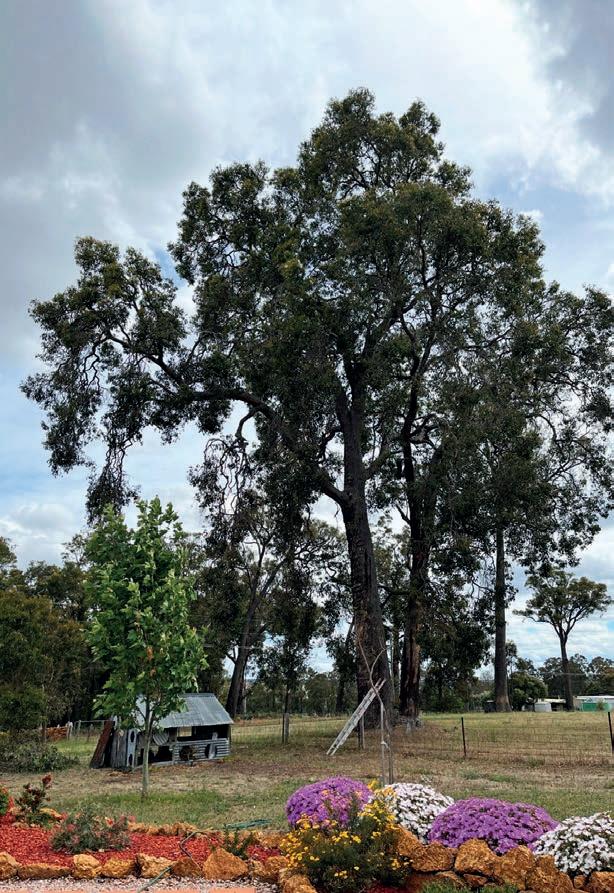
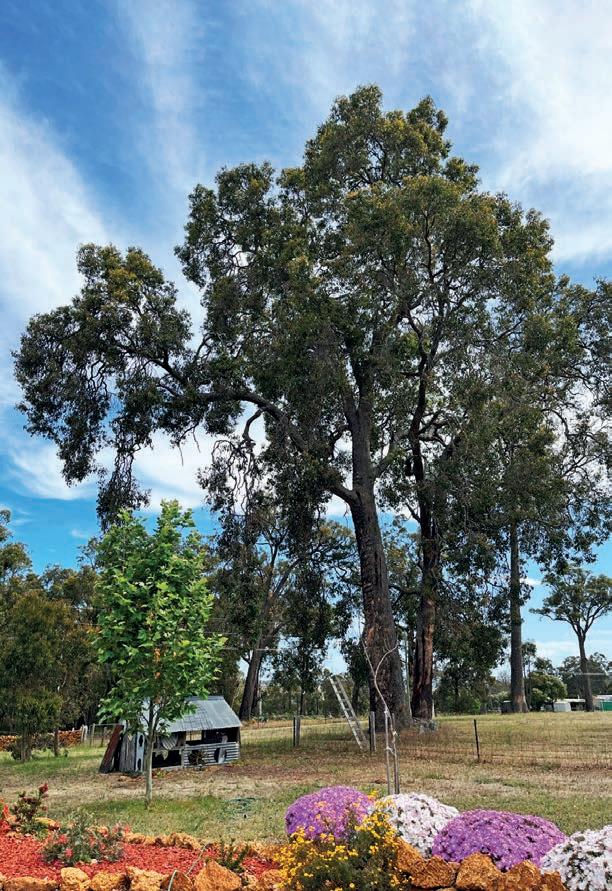
The image to the right shows another neighbouring Marri gum. The dotted lines show the kinds of elongations that cause tension failures in this species. Though I have no problem with large-diameter fractured stubs (micro-bat habitat), for the sake of tree longevity and reduced risk I prefer smaller diameter cuts in the outer canopy. This prevents larger-diameter failure (and therefore risk) in storm events.

The great love of the modern arborist, sensitive reduction (increasing limb diameter in proportion to length) buys decades of extra years for a limb or tree, yet adds to, rather than subtracts from form. Personally I see great value in these long pendulous hanging branches on Marri Gum, exceptional wind dampers.

• Tree health care – often known in arboricultural circles as ‘plant health care’. It’s one thing to have ancient, veteran, and alpha trees in our gardens, it’s another to have healthy trees. Tree health is insurance against tree failure. Like healthy humans, healthy trees are naturally resilient to disease and breakage. Tree diseases like Phytophthora, Phellinus, Chrysoporthe, Marri Canker, Canker Syndrome, and the new kid on the block, Polyphagous Shot-hole Borer (a symbiotic relationship with Fusarium fungi) are common across Australia. Healthy trees are resilient, while stressed or ‘sick’ trees are not. Insuring tree health is all about sustaining healthy biologically diverse soils, supported by air, water, carbon and soil microbiology.
Evidence of wound-scribing by parrots, this I have been documenting on the east-coast going back 15 years, these bird targeted limbs and forks are set up for habitat with repetitious wounding. The problem for trees/tree managers is the causation of tension/branch break-out failure. Even more reason for volume reductions, that reduce failure, whilst sustaining habitation.
I’m currently in Bridgetown, WA, expanding on my relationship with trees Downunder, and one of the great things I’ve witnessed in southwest WA is natural rewilding of roadside verges adjacent to state forest and national parks. As a result of people pressure and herbicide application adjacent to urban and rural land, weeds are better supported than native plant regeneration.
To give perspective, including climbing and pruning, the above operation took 2.5 hours (often reflective of a minimum call out rate). Based on the cheaper end of professional-arborist rates with relevant insurances, equipment and so forth, that would cost $875 (less GST). Done on a five-yearly cycle, while retaining a functional limb and tree, this is reasonable – especially considering
the environmental benefits that such a tree presents.
Complete removal of a large limb such as this is known to significantly reduce tree lifespan, as well as biomechanically setup a tree for upper crown failure.
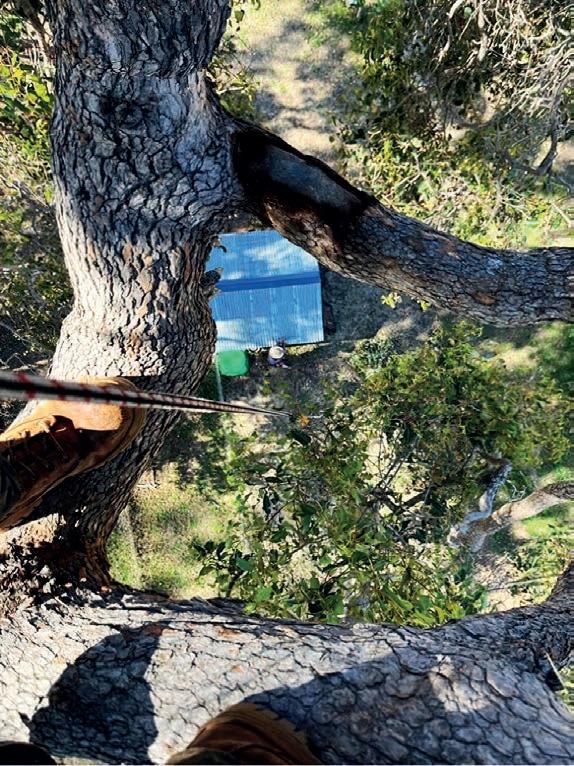
With consideration of the tree as a pump, the father of arboriculture, Dr. Alex Shigo, was the first to make such reference. Trees, in fact most living plants including weeds, fix nutrients in soils. This they do by harvesting atmospheric elements like carbon, oxygen, nitrogen, water and so forth, and building them into their bodies. Via exchange, being eaten and decomposition, plants then make inorganic elements available to all other life forms in organic form.
Next issue I’ll discuss tree health care by attending to the bottom end of the pump.
Pod patches, mini safe havens, tiny forests, biodiversity banks, protected areas, riparian corridors and catchments – these are the terms the new ecoarborist may apply to a site when they assess the canopy and understorey.
An engaged AQF Level 3 eco-arborist will have the duty of relocating fauna and flora when possible, and an engaged AQF Level 5 eco-arborist is a solution to the fast pace of the development process, which is one of the major threats facing ecosystems in Australia. The role of the AQF Level 5 eco-arborist would be to integrate ecology and tree protection into the development process.
A new type of arborist can be a defence for Australia’s depleting ecosystems and bridge the role between bushfire consultants and ecologists.

From the root word, the definition ‘eco’ (oikos) means habitation or dwelling place, and ‘ology’ the study of.
How does this definition apply to the new eco-arborist role in the arboriculture industry?
The habitation or built dwelling place must consider a balance between the new development and the existing environment. In this industry, townplanners, engineers, ecologists and bushfire consultants put the environment second to development. In applying the credits of offsets to a dwelling place, better outcomes with land dedications to community allotments will be achieved. Going forward, the AQF Level 5 eco-arborist can determine where a dwelling should be situated that will have the least impact on the environment. Therefore, the environment can be prioritised over other dwelling-placement considerations, such as views, or accessibility.
Green culture is the summation of the living elements in our ecosystems, and the environment needed to sustain it. Compromise will be needed for
as indigenous persons, threatened species and landowners devastated by environmental impacts. AS 4970-2009
professional tree care. Arborists provide for the care and management of trees in conservation and tree-preservation
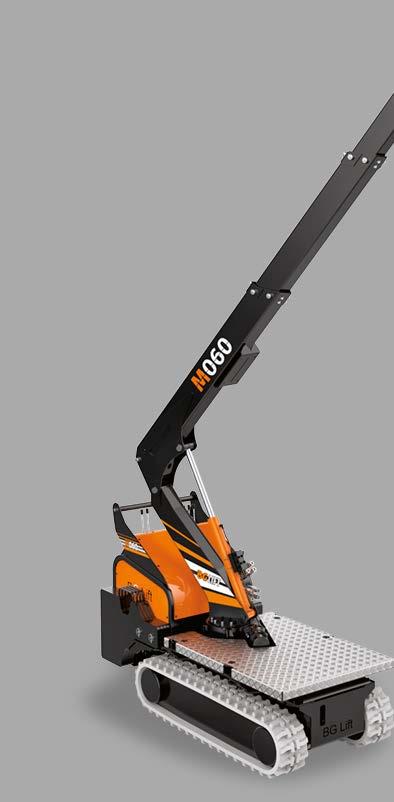

Figure 1: Green Culture Balances – Infrastructure and environment
Environment Green culture out of balanceGreen culture balance
Dwelling place
Dwelling place
Development Development Environment
Jim McArdle raises the flag on eco-arborists and the role they could play in the green culture balances. The article strives to outline the role and responsibility for a brand new profession; The eco-arborist.WORDS AND IMAGES: JIM MCARDLE, HEPHZIBAH CROSSING AND MICHELLE KING
A new type of arborist can be a defence for Australia’s depleting ecosystems.



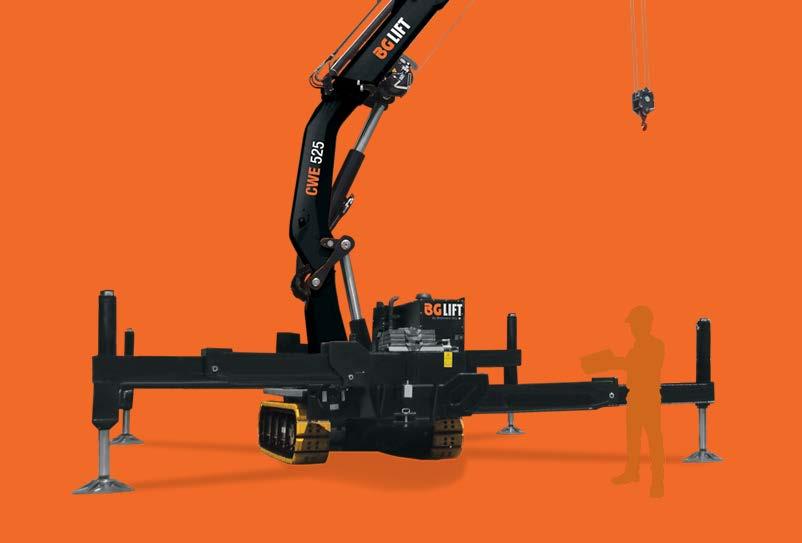







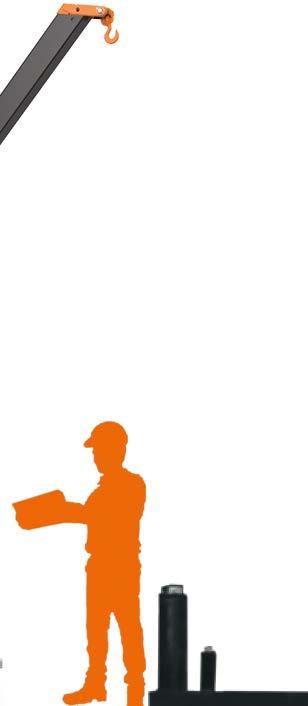

roles, tree climbing, tree maintenance, and the diverse operations of vegetation management, power-line clearance, professional tree management and urban forestry. Consulting arborists have professional consulting, expert witness, research and academic roles in diagnostic testing and tree assessment.


There is the inherent role of care and conservation which leads to the ecoarborist.

An eco-arborist (AQF Level 3 or AQF Level 5) considers the balance between the existing natural ecosystems on site and other constraints that face the development industry. An AQF Level 3 arborist does have an aspect of this mindset now in the course called
support the health, maintenance, and preservation of trees, and to identify and manage risks associated with trees. They are to do this with an ecological mindset, utilising legislative tools and modern technology.
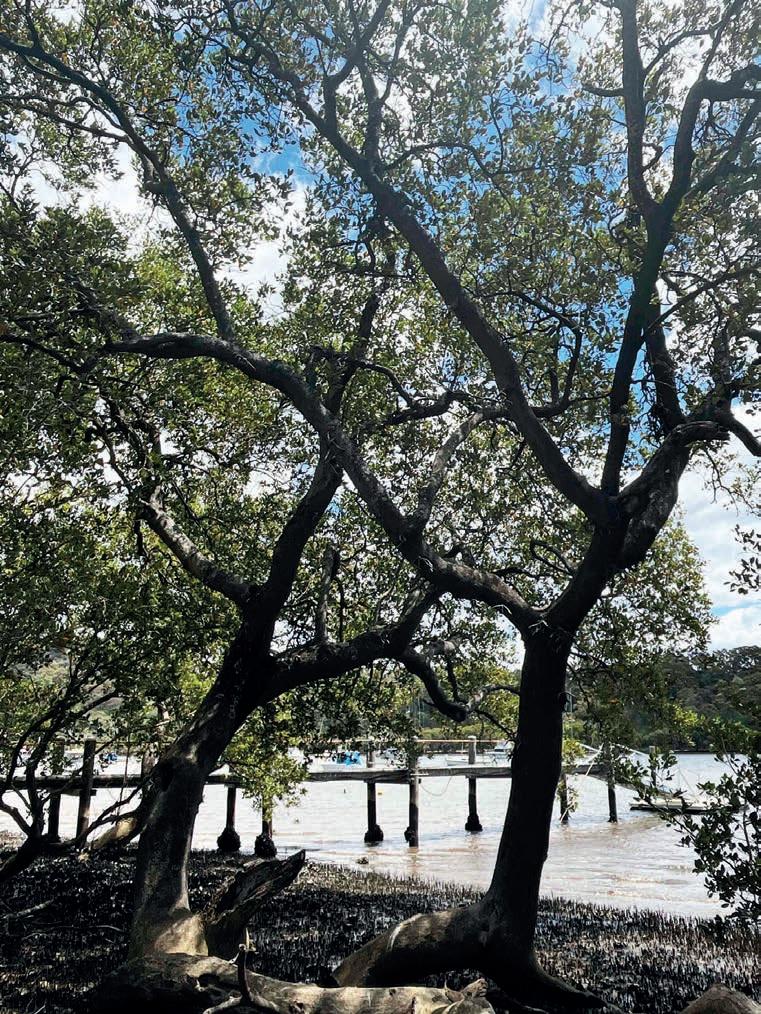
Trees are keystone species. They are grazing grounds, browsing bases and homes for fauna. They are carbon sequesters, atmosphere regulators and resources for humans (medicines, infrastructure, food and so forth).
Larger trees maintain their condition better with less pruning and companion planting, which assists ecological symbiotic and dependent relationships. Tree species which share symbiotic
to co-exist within the similar soil types. It’s important if these are impacted or affected in any development that they remain viable, and if removed are replenished with the same or similar species. It’s a problem to consider larger trees are diminishing in urban areas, and this needs constant vigilance by the ecoarborist to retain and maintain these types of trees and patches where they can regenerate.

Town planners have invested in green culture balances with riparian corridors at the back and front of properties, riparian areas along creeks or around dams (not on the wall itself), and ‘biodiversity pods’ where they can have inter-canopy species habituating and mutual symbiotic relationships in the understorey and canopy trees.
Prominent trees will also be required to be utilised for amenity along purposebuilt roadways and paths as the need for more localised modes of transport increase – lesser road vehicles like motorised scooters, electric bikes, skateboards, walking and other modes of transport.
Grants for increasing community fitness and transport are currently available, indicating the movement to lesser use of private motor vehicles. The rising costs of fuel are a heavy deterrent to these traditional types of transport.

In the design and manufacturing of these spaces which impinge on local patches of endemic vegetation currently retained for remnant vegetation or biodiversity, more inductions of workers unfamiliar with entering biodiversity areas or regenerative pod-cell areas are required to reduce biosecurity issues and the transfer of pathogens and toxic chemicals utilised in the building industry to plants and environment. Things like footbaths, cleaning equipment with disinfectant and reduced soil on machines, and utilising only pest and certified diseasefree mulch as per the Raw Mulch Order, reducing access and involving eco arborists with a biodiversity background.
Town planners have invested in green culture balances with riparian corridors along creeks or around dams.
Very simply, we need eco-arborists to promote the preservation of larger sentinel trees and prominent trees, to reduce the number of large sentinelsignificant and prominent tree removals,





and to develop a better balance between infrastructure and the natural environment.
In review of the work done by the experts and ‘smart and skilled’ in the placement of new arboriculture pathway training to suit the promotion of values associated with green culture: Currently the new qualification for the AQF level 3 Eco-arborist who can select the following units from the Training Arb packages: (From Gov.au Arb training package. The four units are electives, and there are eight core units to be achieved from the skill set.)
There are two ends to the spectrum of mass tree removal scale that are noticeable in the arboriculture industry.
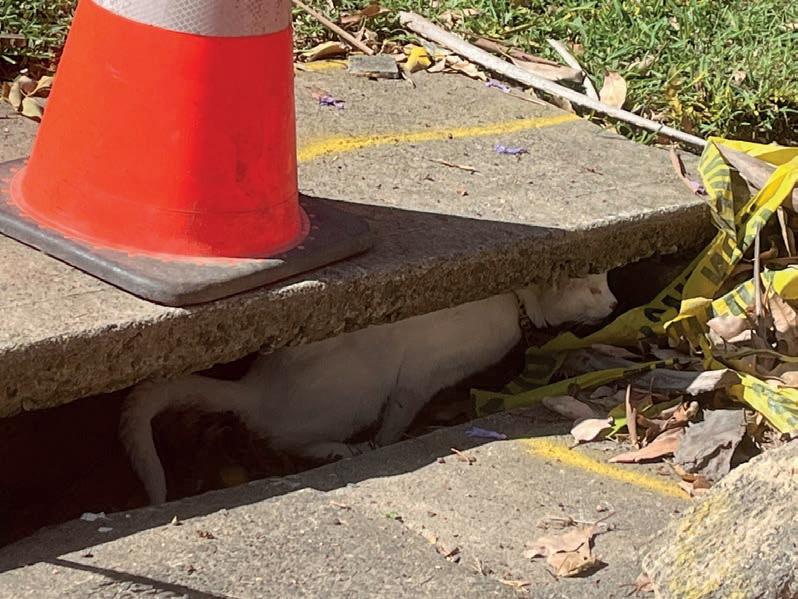
AHCARB325
AHCFAU201 Recognise fauna
AHCLPW304
AHCNAR202
Table 2: Table 2 AQF level 6 relevant ecological Unit
AHCARB609 Measure and improve the performance of urban forests
In view of the Arboriculture Pathway, the progression from Cert II junior to senior arborist with Graduate Diploma Cert VIII is presented with the current qualifications which are stated in from the training packages manual.
On one end of the spectrum, we have urban development in our cities to meet the demand for housing. More apartment complexes are being built, new houses are as tightly packed as a can of sardines, and there is an increasing number of attached dualoccupancy dwellings. The bigger the footprint of these developments and the more crammed together dwellings become, the more trees get removed
and the less room there is to replace sizeable trees of ecological importance. This is where the ‘urban heat island effect’ comes into play – more heat is being trapped in our cities because there are more urban surfaces (roads and buildings) than green spaces, too many trees are being removed and squeezed out of this space, and there is not enough vegetation to provide shade and release moisture back into the atmosphere.
In the UK the government pays farmers a stipend to retain their trees and now to rewild3 their lands – their green spaces are valued. Innovations have
Natural balance of ecosystems needs to be taken into account so indigenous species aren’t overrun by feral intruders.

been attributed to young trees on roof spaces, walls and balconies, increasing density of canopy cover with tiny forests. Trees can survive and flourish in a built environment, but only if a tree’s system is not impaired by the development that it is supposed to enhance (Sullivan.B.2015v32022), people like to live with trees around them.

From nature we can get a perspective of possibilities with design, engineering and climate adaption.



A picture’s worth a thousand words and this is relevant when presenting this concept... please see Plate 1 above.



At the other end of the spectrum, there are people developing out in the bush where Australia’s biodiversity values and endangered ecological communities (EEC) are found. Developments in the bush generally require large clearings for the construction of onsite wastewater systems, as well as the removal of trees and understorey vegetation to reduce the risk of bushfire. AQF Level 5 arborists providing



Pod patches, mini safe havens, tiny forests, biodiversity banks, protected areas, riparian corridors and catchments – terms the new eco-arborist may apply to a site when they assess the canopy and understorey.
consultation for these developments will often face the struggle of preserving EEC trees with biodiversity value while choosing which trees face removal to meet the requirements of a bushfire Asset Protection Zone (APZ).

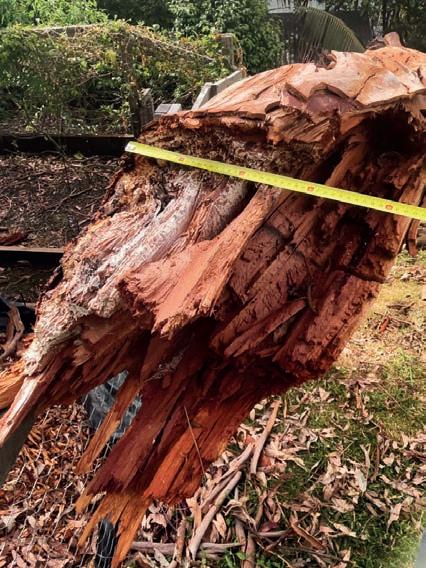
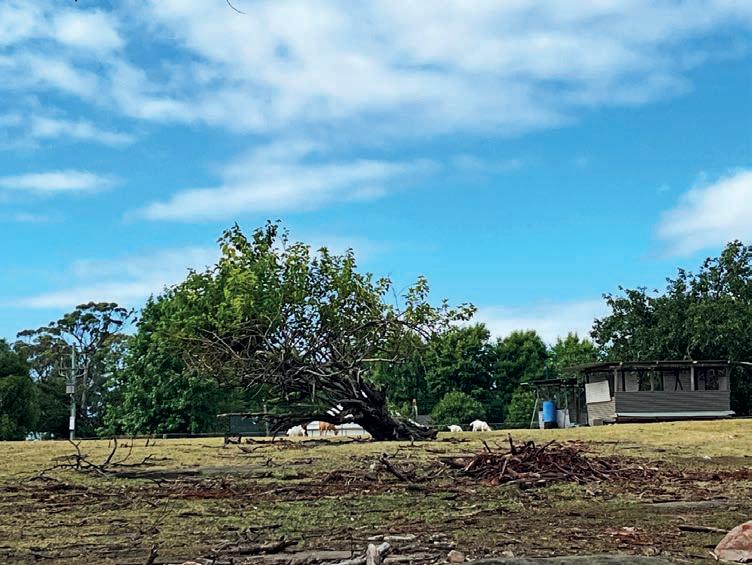
The other issue of meeting APZ requirements is understorey vegetation and shrubs, generally overlooked by inexperienced arborists, are the first to go when satisfying the requirements of a bushfire APZ. This vegetation is just as crucial for a healthy and functioning ecosystem as canopy vegetation. It contains about 90 per cent of plant species diversity in Australian ecosystems2 and it provides food, nesting materials, shelter and soil stability. Raising the flag on arboricultural experts to give appropriate commentary and advice is essential to balancing the development paradigm.

These sorts of developments are the ones that require many report amendments and reviews with council, and many prospective homeowners can get caught out by the costs of these amendments and other requirements, such as Biodiversity Development Assessment Reports (BDAR), or by not completing pre-da assessments to assist in the development process.
Both our experienced and upcoming arborists in training need an eco-mindset.


The RUTHMANN Bluelift SA18HB tracked spider lift maximizes production without sacrificing safety while working at height. This compact model features a maximum working height of 17.8m and a maximum horizontal reach of 9.3m and is perfect for areas with rough or uneven terrain. A gradeability of up to 28% and self-stabilizing system make it the ideal machine for a variety of arboreal tasks.
Ahern Australia is the exclusive distributor of these safe and reliable spider lifts in Australia.
For more information on the Ruthman Bluelift SA18HB, please call 1300 900 700 or visit ahernaustralia.com.au.
 RUTHMANN
RUTHMANN
The role of an eco-arborist is to support the health, maintenance, and preservation of trees, and to do this with an ecological mindset, utilising legislative tools and modern technology.
• We need crossover academics from biodiversity conservation and town planners (with sympathetic ecological values) determining legislation and raising issues in the political communities;
• We need arborists with backgrounds in ecology to preserve our biodiversity values and EECs (endangered ecological communities) and earth sciences;
• We need eco-arborists in council and government positions to regulate and restrict the land being made available for housing within protected areas of biodiversity and logging, especially in koala management areas (KMA);
• We need eco-arborists who can resist the use of toxic chemicals into the environment, and flag biosecurity issues and transfer of non-certified green waste;

• We need AQF Level 3 arborists who know how to prune for wind exposure and habitat. This may include the pruning of spaces or holes for habitat egress and into the canopy, branch or stem, build and install nesting boxes with noted access and egress requirements of the specific habitat, have climate-specific knowledge and understand the relationship between interspecies. They need an understanding of water uptake in the current climatic times, the

role of fungi associations and how these abiotic and biotic conditions can benefit development rather than being detrimental. • We need local experience within the region or responses from experts that would prepare the developments from a local biodiversity perspective. This can be as easy as referring to local arboricultural experts or ecologists.
Local TCAA arborists are good at instructional work and are practical people6. An analogy is that they would be similar to working in a closed system like submarines. Unfortunately, if one of the team makes a mistake, the changes could be catastrophic, unless experience with foresight and best industry practice to overcome obstacles, dangers and reduce the risks is brought to the fore. TCAA have regular meetings to develop policy and training to cater for the new changes. Weather anomalies and microbursts are placing un-treed or recently cleared areas at risk of landslip or erosion, either of which is costly to remediate.
Under scrubbing has been mass performed under NSW state legislation due to the requirements for bushfire management. This legislation is named the 10/50 Vegetation Clearing Code and it allows for tree removal within 10 metres of a dwelling and under scrubbing within 50 metres. In general terms, clearing the understory leads to a reduction of the regenerative capacity of any site, and this may have a flowon effect to the fertility of the soil. For example, the loss of acacia species – wattle – has led to a reduction in plantavailable nitrogen, increased soil compaction, and reduced
An eco-arborist should thus have the authority to give options for significant trees impacted by the bushfire requirements on development sites.



are removed. In Hornsby Shire, the Melaleuca quinquenervia (Broad-Leaved Paperbark) is under-represented. In the Hawkesbury City Council area, Eucalyptus tereticornis (Forest Red Gum) trees are water stressed, and in the west the attacks of insects and psyllids have almost destroyed large patches of the Eucalyptus mollucana (Grey Box) over the past 10 years.
Clearing is a key threatening process according to the Threatened Species website. Also, clearing compacts the soil levels from machines driving through the TPZ of tree communities. This in turn reduces pore space for air and diffusion of gases and water percolation from the surface (zero A0) grade. There is an area within developments where we should propose a ‘pod patch’ – an area where species regeneration can occur and also allow ‘mini safe havens’ where threatened habitat or any habitat can be protected. The dual purpose of this area is essential for continuation of the existing species regeneration.
The Albanese government just released a report on the environmental law which was scathing of the archaic biodiversity laws. From The Conversation: ‘Evidence shows offsets have so far been largely ineffective, in part because existing policy is not properly implemented and rules not enforced. They may even facilitate more biodiversity loss by removing ethical roadblocks to destroying ecosystems and habitat for threatened species.’
On the topic of clearing, Professor Greg Moore comments on how the riparian ecology along our roadsides is thinning and patching, possibly from collisions or weed management .
What is the new role in the industry which can reflect the values and ideas of the above we are proposing?
To test or further survey the understorey vegetation for retention values against; fertility, reproductivity, habitat, protection of species (both flora and fauna) and associations that improve soil health and canopy cooling. Breaks in canopy corridors reduce the migration of inter-canopy species, as well as the number of food-source trees which are also found in the understorey.
New policies in arboriculture consider changes in weather patterns, which will assist the new eco-arborist. The increase in moisture volumes (BOM) has a direct relationship with colonising fungal
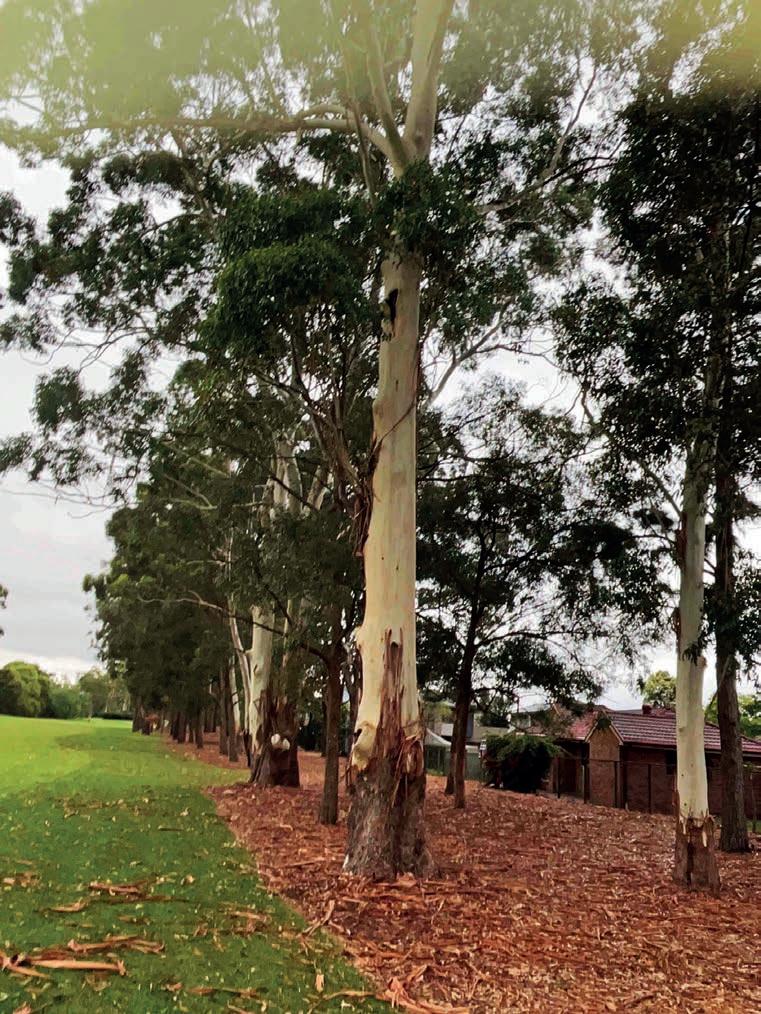
fruiting bodies and weaker limbs from being heavy from moisture. Higher wind forces are increasing storm-damaged vegetation dislodging from supportive roots and fractured branches. The effects of taking a tree out on other local vegetation is also required as numerous site reports on trees where a large tree was taken out nearby as dislodged a retained tree because of the additional forces on the exposed tree. This question must be asked, ‘If we take out the tree here, what is the effect on the surrounding vegetation’.
A new panel of experienced ecoarborists would be best to determine tree loss and effects intermediate to the Land and Environment court that is free from council constraints, but has the backing of the federal and state governments, and acts under the revised biodiversity act – a level of scrutiny that may be best, rather than the hopscotch of several different views on tree management from local councils.
With the new eco-arborist role poised to be a key to developing the Green Culture Balance, again we face the shortage of trained and skilled arborists.
Hopefully the new panels of discussion on the role our industry can assist will assist our skills shortage and reduce the bizarre offset that previous legislation has promoted. In addressing the new rules let’s get the flag raised on this.
Land useage from the map of Australia (2016) notes the decline in land used for farming – please see Figure 3 on the opposite page.
– AS4970 2009 Tree protection On Development Sites.
Another unfortunate rise of habitat roosting in homes as the loss of canopy progresses.
Microbats found in walls, between weatherboards, possums in roofs, and large gatherings of birds seeking shelter and food. An eco-arborist needs to account for these changes in the field and insist on adequate controls. There needs to be a system of more regular inspections on fit-for-purpose vegetation within infrastructure hubs.
Noting that the increase in fungus due to moisture variants, changing biota and trees evolving or adapting to meet these new rules would be a worthy study.
– King. M & McArdle J.(2022) Pre-DA-Assessments, Arbor Age, Australia.
– McArdle D&J (2022) TCAA TMG Tree Management Guidelines. Best Industry Practices Australia.
– McArdle.J (2022) Practical People TCAA, December-Jan Arbor Age Australia
– https://theconversation.com/our-laws-fail-nature-the-governments-plan-to-overhaul-them-looks-goodbut-crucial-detail-is-yet-to-come-196126
– https://theconversation.com/roadside-trees-stitch-the-ecosystems-of-our-nation-together-heres-whytheyre-in-danger-175337
– https://www.narla.com.au/blog/hv2s09y42rowp4q6cpiftdhmpheg99
– AHC-Training Packages Volume 8 Dept Training.Gov.Au 2022
– https://soe.environment.gov.au/theme/land/topic/2016/land-use-and-management

The QAA has certainly hit the ground running in 2023. By the time you’re reading this we will have already run our first workshop for the year with another one just around the corner.
Events are a big part of what the QAA does, as we believe that by providing continual learning opportunities, we can help improve skill sets and quality of work. This, in turn, will make the industry safer and more efficient for everyone working in it.
You can check out our complete list of 2023 events in our Events Directory on our website (qaa.net.au).
In November 2022, the QAA held its 30 Year Gala Dinner. It was a great night of catch ups, dinner and dancing as we celebrated 30 years of the QAA at the Hotel Grand Chancellor Brisbane. As QAA President Henk Morgans said, “Everyone scrubbed up well for a bunch of tree people.”

During the night we also presented a number of awards to individuals and businesses making a difference in the industry.
Thank you to those who attended the Gala dinner and to everyone who submitted a nomination and voted for the award finalists. We received almost 5000 votes in total across the award categories. To see this level of support for our finalists was very special.
• Apprentice of the year: Tauaiti Caulcutt
• Mentor of the year: Jamie Boston
• Best Picture award: Scott Crane
• Industry Innovation award: Enviro Trees (formally Enviro Frontier)
• Sustainable Practices award: PowerClear
• Lifetime Member award: Alice Rankine
As a not-for-profit association, the QAA couldn’t do what it does without the support of wonderful sponsors. There were several new sponsors who joined us last year and we sincerely thank them, as well as our longer-term ones,
For info call QAA on (07) 3821 1488, email office@qaa.net.au, or visit www.qaa.net.au. Follow us on Facebook (QueenslandArboriculturalAssociation), Twitter (QLD_Arb_Assoc), Instagram (qaa_arborist), LinkedIn (queenslandarboricultural-association) or via the QAA App.

for their continued support of both us and the industry in general.
Sponsorship sales for the 2023-24 year, which come into effect from July 1st, open in March with multiple places available for new sponsors. Sponsors of QAA help the association give back to members in many ways, including through reduced ticket prices at events. This allows more members to attend,
connect, learn new skills, gain valuable practical experience, and test their climbing ability against others in the industry.
Sponsorship packages are sold on a first-come basis. If you are interested in learning more about becoming a QAA sponsor, you can request a Sponsorship Package by emailing office@qaa.net.au.
To view more information about any QAA events and to book tickets, visit the Event Directory on the QAA website.
On Tuesday, February 28, award-winning Australian arborist Mark Hartley will present a workshop where attendees will gain a better comprehension of the contents of the AS 4970-2009 Standard (Protection of Trees on Development Sites), its application and future development. Since the adoption of the
QAA – delivering excellence in arboriculture.
Standard there appears to be a lot of misunderstanding about its purpose, and as a result it is regularly misused as a set of specifications.
Rather than applying professional knowledge of tree roots and tree physiology to make educated decisions about trees on development sites, too often expressions like, “You can’t come closer than a 10% encroachment,” are used by municipal and consulting arborists alike.
After the workshop, attendees will more confidently assess the ongoing impact of development on the trees and will be able to think outside the box to address major encroachments. This workshop is suited to consulting arborists, council arborists, and any other arborist looking at trees on development sites.
QTRA (Quantified Tree Risk Assessment) training will take place at the QAA head office on Thursday and Friday, March 2nd and 3rd, 2023.
As a registered user of QTRA, attendees will be able to apply established and accepted risk-management principles to tree-safety management by quantifying the risk from tree failure as a probability in accordance with widely applied and internationally recognised levels of
of risk they pose, and costs of risk management.
QAA but is run by QTRA.
The QAA’s first climbing competition for 2023 will take place on Saturday 18 March.

The QAA Amateur Open is always a fun event. There is something for everyone, with all levels of climbers welcome. In 2022, this ranged from climbers with 12 hours experience up to state champions.
The focus of the QAA Amateur Open is to introduce the conditions and requirements involved for ISA Tree Climbing Events. While winners will not qualify for nationals at the event, they will gain the knowledge and experience required to participate in the Queensland Tree Climbing Championship (QTCC) and will be in the running to win some great prizes.
Thanks to event sponsor Husqvarna Australia for its support of this event.
Experienced trainer Bryan Gould is
assessment during three progressive sessions – Tree Structure and Function, Tree Nomenclature and Taxonomy, and Tree Assessment.
After completing this workshop, attendees will be familiar with defining tree biological processes, understanding tree nomenclature/taxonomy, and linking these factors into a practical and/or written tree assessment.
This workshop is suited to arborists working within the industry, whether aspiring or experienced. Information is complementary and supplementary to AQF certificate/diploma studies.
Bryan will be running a series of workshops for the QAA in 2023 and early 2024 covering a range of tree-related topics.
QAA is offering discounted bundle rates if you want to attend more than three workshops, with businesses able to book a bundle rate and send different people to different workshops.

To learn more and book a bundle rate, visit qaa.net.au/bryan-gould-workshop-

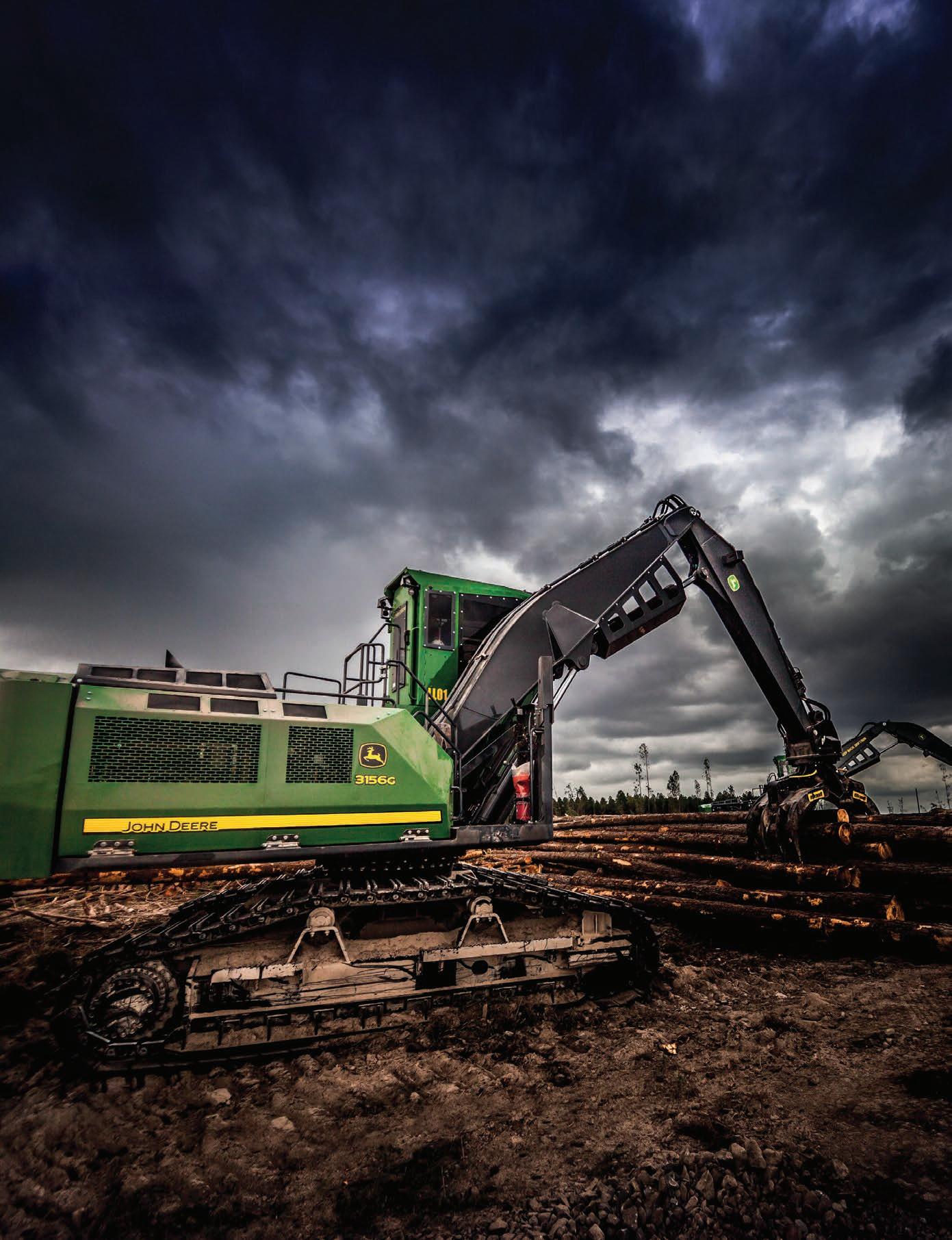
TTIA was recently informed by Safework NSW that from October 1, 2022, new requirements came into effect for businesses to manage psychosocial risks in the workplace.
The WHS Act defines ‘health’ as including both physical and psychological health. A PCBU (Person Conducting a Business or Undertaking) has a primary duty to ensure, so far as is reasonably practicable, the health and safety of workers, and also to ensure other persons are not put at risk from work carried out arising from the business or undertaking.
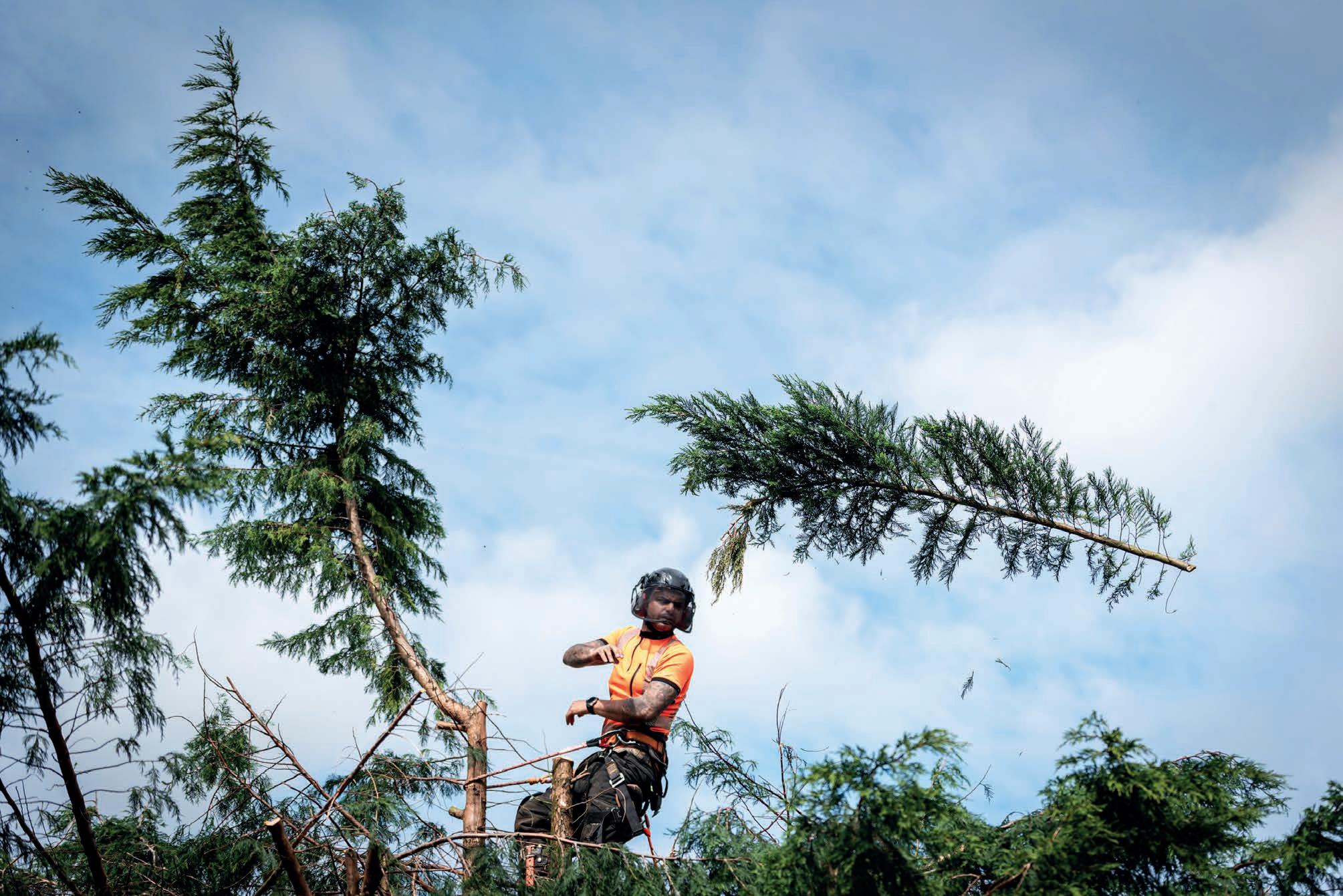
Safework advises that when psychosocial hazards and risks at work are not effectively managed, it may increase the risk of work-related psychological and physical injuries, incidents and errors. Therefore, it may be helpful when assessing the risk of musculoskeletal and traumatic injury to consider the psychosocial hazards and risks and controls noted in the code.
Safework maintains that ensuring a systematic process to manage
Brian Beecroft – CEOpsychosocial hazards and risks will help the PCBU and duty holder meet their WHS responsibilities. It will also decrease organisational disruptions and costs resulting from work-related harm and may improve WHS and broader organisational performance and productivity.
The Work Health and Safety Amendment Regulation 2022 (the Amendment Regulation) adopts the model provisions on psychosocial risks that were published by Safe Work Australia earlier this year
The Amendment regulation inserts new provisions on the management of psychosocial risks in the workplace including:
• New definitions of psychosocial hazard and psychosocial risk, and clarification of the control measures required by businesses to manage those risks;
• Complements the existing Code of Practice – Managing psychosocial hazards at work. The Code of Practice provides guidance for businesses to identify and manage psychosocial hazards at work; and
• Addresses a recommendation of the national Respect@Work Report on sexual harassment in the workplace.
TTIA has developed a psychosocial policy and risk assessment. It is recommended these be included in your company health-and-safety documentation.
If you would like a copy, or are interested in accessing the TTIA’s Workplace Health & Safety Unit, please contact the TTIA office on (02) 9264 0011, or by email at ttia@ttia.asn.au.
There is also a copy available for members on the TTIA website at www.ttia.asn.au.

The John Deere G-Series Forestry Swing Machine will redefine your expectations about what a swing machine can accomplish. With eight models rated from 28 to 48 tonnes, all featuring robust undercarriage and mainframe, upsized swing bearings, reliable John Deere engines and superior hydraulics, their capabilities are industry-leading. And so is the operator comfort.
The spacious cab boasts plenty of legroom and is isolation mounted to reduce noise and vibration, significantly reducing fatigue. Plus attention to ergonomics provides precise fingertip control with less movement or effort. There are even creature comforts like climate control and a heated/cooled seat.
Find success in the forest with a John Deere G-Series Forestry Swing Machine.



Rey from Forest Centre points out some advantages and safety considerations of using this titan of mechanised arb.
requires careful evaluation in terms of the chosen attachment, but also your host equipment, operator training, work process and likely job sites.”
One major difference in risk profile when moving between handheld chainsaws and hydraulic saw units is ‘Chainshot’. Explained briefly in a previous AA issue, Chainshot is a phenomenon that can occur in mechanical harvesting and processing applications, as well as grapple-saw work. It is the high-velocity separation of a piece or pieces of cutting chain from the end of a broken chain. Chainshot occurs when the end of a broken chain is rapidly accelerated due to either an impact with a portion of the cutting head or a whip-like motion of the chain end. Chainshot can have as much kinetic energy as a bullet fired from a rifle, easily penetrating conventional safety-window material on mobile plant with potentially fatal consequences.
First, the saw chain breaks.
ground, removing the risks of using a chainsaw at height. The attachment grabs the section to be removed, and the saw then cuts it, avoiding the need to tie it off to the tree prior to cutting.

The use of this equipment poses a series of new risks, though.
On the machine side, there is concern about the unknown weight and balance of the load and how suddenly taking the weight at height affects the stability of the machine or the rated capacity indicator. On the human side, experts also warn of risks associated with the saw itself.
“A grapple saw can be an incredibly productive tool,” explained Rey Kell, Director of equipment supplier Forest Centre, “though they can present new risks and they are of course not a replacement for conventional methods for every job.
“Applied safely, some of the machine and attachment combos available to arborists today can be considered as a level-up or an extra arrow in the quiver for a crew with climbers, an EWP or bucket truck,” added Rey.
on purpose-built forestry carriers, while their application specific to the tree-care industry is relatively new. The number of highly specialised grapple-sawequipped truck cranes in Australia and New Zealand today, for example, could perhaps be counted on one hand.
Excavators, by comparison, are much easier to come by, and seemingly straightforward for equipping with a range of work tools such as grapples and mulching heads when operating close to the tree is possible. Small excavators with thumb grabs or hydraulic grapples are already well-utilised by many arb crews, and for many businesses there is little barrier to entry for taking the next step up to a larger excavator capable of more lift and reach for grapple-saw use.
“We are well-versed in hydraulic saw units from our years of supporting high-production forestry attachments here in Australia,” explained Rey from Forest Centre. “The basic concept is the same for grapple saws and felling grapples used in tree care, however not all units are alike in terms of their safety requirements. This is an area that
Second, after a saw chain breaks, the ‘free’ end of the saw chain begins to whip away from the break.
Third, if the saw chain is not contained by the saw box or a chain shot guard, the broken saw chain’s free end can speed up rapidly, carrying immense dynamic energy. Finally, at the peak of the whip, saw chain pieces may break loose and be ejected at high speed.








Silky Hayate pole saws cut through practically anything they tackle… until you hit the whippy stuff, that is – branches that won’t keep still and move around too much for the supersharp teeth to get a bite on.

A solution has been found. The Sintung lopper!
ATC Products has developed a connector so the Sintung lopper can easily be attached to any of the four different-length Hayate pole-saw poles. Simply slide the connector into the lopper head, attach it with the screws provided, then use the existing Hayate yellow screws to connect the Sintung to your pole


Being a ratchet-style lopper means the operator doesn’t need arms the length of a chimpanzee’s to use it. Pull the rope until the blade bites in, then lift your arm and it will lock into the first gear. Repeat until you’ve cut through.
The parrot-beak style also helps by stopping the branch from wriggling out of position.
With this new combo, all your highreach pruning needs are sorted!
For more info call 07 3823 1599 or visit www.atcproducts.com.au.
ATC
A long reach and great cutting power thanks to a clever accessory.The Silky Hayayte telescopic pole saw cuts through practically anything except whippy branches that flex a lot. Products has developed a connector so the Sintung lopper can easily be attached to any of the four different-length Hayate pole-saw poles, giving it maximum reach.
Getting the job done faster and more efficiently has to be at the top of the new year’s resolution list for anyone doing tree work. Intermercato grapples are known as the arborist’s choice and have the special ingredients to speed your way through your workload like never before in 2023.


Exceptionally lightweight, with a large opening to take big logs and loads, they are designed to get the most out of your mini digger so you can power through each job and get on with the next. All Intermercato grapples are imported directly from Sweden and constructed with genuine Hardox steel.
The Intermercato Australia team believe it’s important to tailor your grapple set-up to suit your individual preferences and machines. That’s why you can choose from an Intermercato grab or grab-and-rotator assembly.


An optional rotator is available with all grapples and the Intermercato Australia team carry a large range of rotators to suit every requirement. According to the team, using a rotator can make your machine 30% more productive.
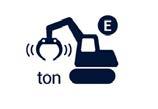

Worm-drive rotators allow you to hold limbs in the air and prevent them falling down on a customer’s fence or roof – a handy quality on the job! Another type of rotator, the RMR style, is super speedy and perfect for feeding chippers.
An additional rotator will add approximately 40kg to your kit, and if you only have one set of auxiliaries, Intermercato Australia’s in-house customisation team can use a 12V diverter valve to allow switching between grab and rotator with the press of a button in your cab.

Customisation is all part of the service at Intermercato Australia. A phone call or email chat with the expert team will provide advice on how best to fit an Intermercato grapple to your digger, and any adaptation can be carried out in their inhouse workshop.
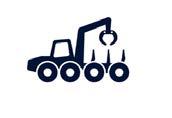
Last year’s supply issues are now a thing of the past, and Intermercato has plenty of stock. The range includes:

• Log grab TG12S 70kg – opens to 765mm wide, suits 1-2T
• Log grab TG16S 80kg – opens to 925mm wide, suits 1-3T
• Log grab TG22S 140kg – opens to 1310mm wide, suits 2-4T

• Five-finger grab TG12SR5 – 80kg opens to 810mm wide, suits 1-2T
• Five-finger grab TG16SR5 95kg – opens to 950mm wide, suits 1-3T

• Five-finger grab TG16PROSR5 105kg – opens to 930mm wide, suits 1-4T.




All grabs are delivered Australia wide with a hydraulic hose kit and couplers ready to work.

Contact Robert on 0436 028 643 or visit grapples.com.au.

Go back to work after the holiday break with the arborist’s secret weapon.Intermercato grapples are known as the arborist’s choice.
Forest Jacket – Technical
Made with tough yet lightweight fabrics and task-oriented design, The Forest Jacket, Technical is ideal for everyday forestry work. Made using four-way stretch polyester and a crafted fit guarantee comfortable movement and reduced effort. Ventilation openings on the yoke and lower back ensure comfort and performance.

Rec. retail price including GST: $345
Inspired by the best athletic wear, protective clothing from Husqvarna comes with built-in agility and a host of features to enhance comfort and performance, all without compromising safety.
Husqvarna’s range of work wear and protective clothing takes season, weather and temperature into consideration - as well as the job you are facing.
Scan this QR code for more information on the Husqvarna Work wear range
• Pockets for mobile storage have a padded lining for a mobile phone, keeping it well protected and within easy reach
• A zipper closure at end of the sleeves allows size to easily be adjusted depending on user, gloves and other variables
• Openings at the yoke and the lower back make for good ventilation
• Ventilation zippers under the sleeves in the armpits allow adjusting the airflow to the wearer’s liking
• Stretch fabric on the upper back and sleeves allows free, safe and comfortable movement

• A dedicated first-aid pocket gives easy access
• Cordura® heavy-duty fabric delivers high functionality and exceptional comfort. Husqvarna Cordura® heavy-duty is used on the most exposed areas of the garments – around ankles and wrists, for example. The fabric has a Teflon® finish which helps repel water, oil and stains. 220g/m2. 100% Cordura®
• Aramide Mélange is a fibre composition combining abrasionresistant Kevlar® fibres and hardwearing Cordura fibres. Husqvarna uses the tough fabric reinforcement on exposed areas. 240g/m2. 45% Cordura®/30 % Polyamid/25% Kevlar®
• Breathable fabric gives high movability in areas where it is needed and provides comfortable movement. 235g/m2. 92% Polyester/8% Lycra®.
• Sizes: S-XXL.
These are light and cool shirts made from recycled polyester and available in either short- or long-sleeved variants.
With a zipper front, extended back and easy-access zipped front pocket, the shirts are ideal for work in warmer weather. The material helps transport moisture away from the body and dries quickly, helping you keep your cool when working hard.
Rec. retail price including GST: Short-sleeve $64.95. Long-sleeve $74.95
• Quick-drying fabric helps transfer moisture away from the body, keeping skin dry
• Pocket with zipper for easy access and safe keeping of belongings
• Zipper front with half-zipper for easy access and to be able to open for extra airflow.
• Sizes: S–XXXL.
Forest Jacket – Technical Extreme
Designed for long shifts in the most challenging environments. The Forest Jacket, Technical Extreme is made using lightweight, breathable fabrics and has pre-bent elbows to increase movability, while effective ventilation openings on the yoke and lower back keep you cool when working hard. High-visibility fabrics and reflex bands feature in the jacket’s design.
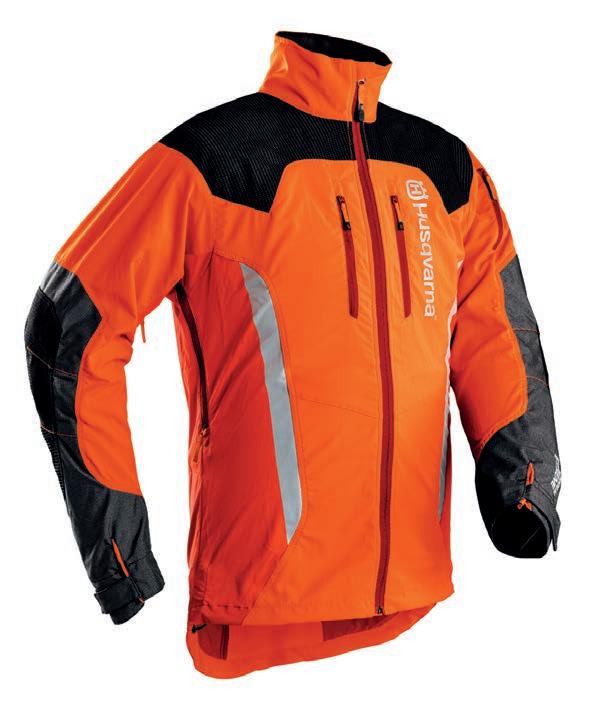

Rec. retail price incl. GST: $479
• Chest pockets have a padded lining for a mobile phone, ensuring it’s well protected and within easy reach
• One pocket with a zipper on the left sleeve allows the user to keep belongings in the pocket during work with easy access
• Openings at the yoke and the lower back make for good ventilation
• Ventilation zippers under the sleeves in the armpits allow adjusting the airflow to the wearer’s liking
• A dedicated, easy-access first-aid pocket
• Hook-and-loop adjustment at the end of the sleeves allows size to easily be adjusted depending on user, gloves and other variables
• Husqvarna’s light, four-way stretch fabric stretches in all directions, crosswise and lengthwise, allowing high movability in areas where it’s needed, and providing maximum comfort. 190g/m2. 88% Polyester (14% Polyester Coolmax®)/12% Elastane Lycra®)

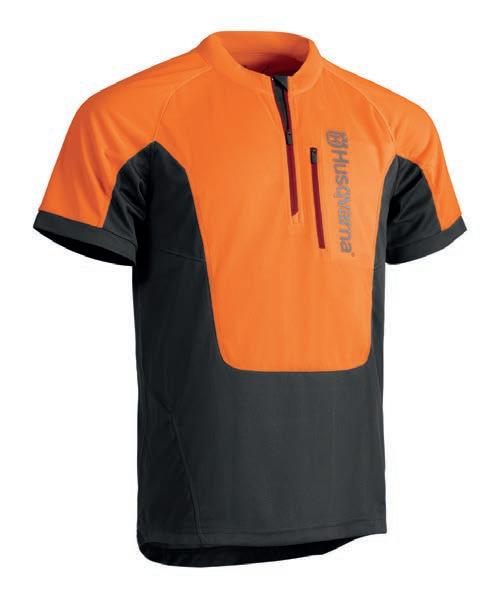
• Feather stretch – Husqvarna’s lightest fabric – with two-way stretch, is used for areas in need of a great movability. The fabric gives freedom of movement and high comfort. 185g/ m2. 66% Polyester/34% Elastane
• Cordura® reflex fabric delivers the tear and wear resistance needed on the most exposed areas. Reflective yarn in the fabric gives high visibility in dark and dim conditions. 335g/m2 100% Polyamide
• Cordura® checkered fabric delivers the tear and wear resistance needed on the most exposed areas. Coated on the back for improved waterproofness. 225 g/m2. 100% Polyamide.
• Sizes: S-XXL.
Here in Australia, many in the tree industry have now seen the benefits of the spider lift; a machine concept that offers versatility, accessibility and transportability all rolled into one. With around 10 brands now available in Australia, the options presented can be confusing.

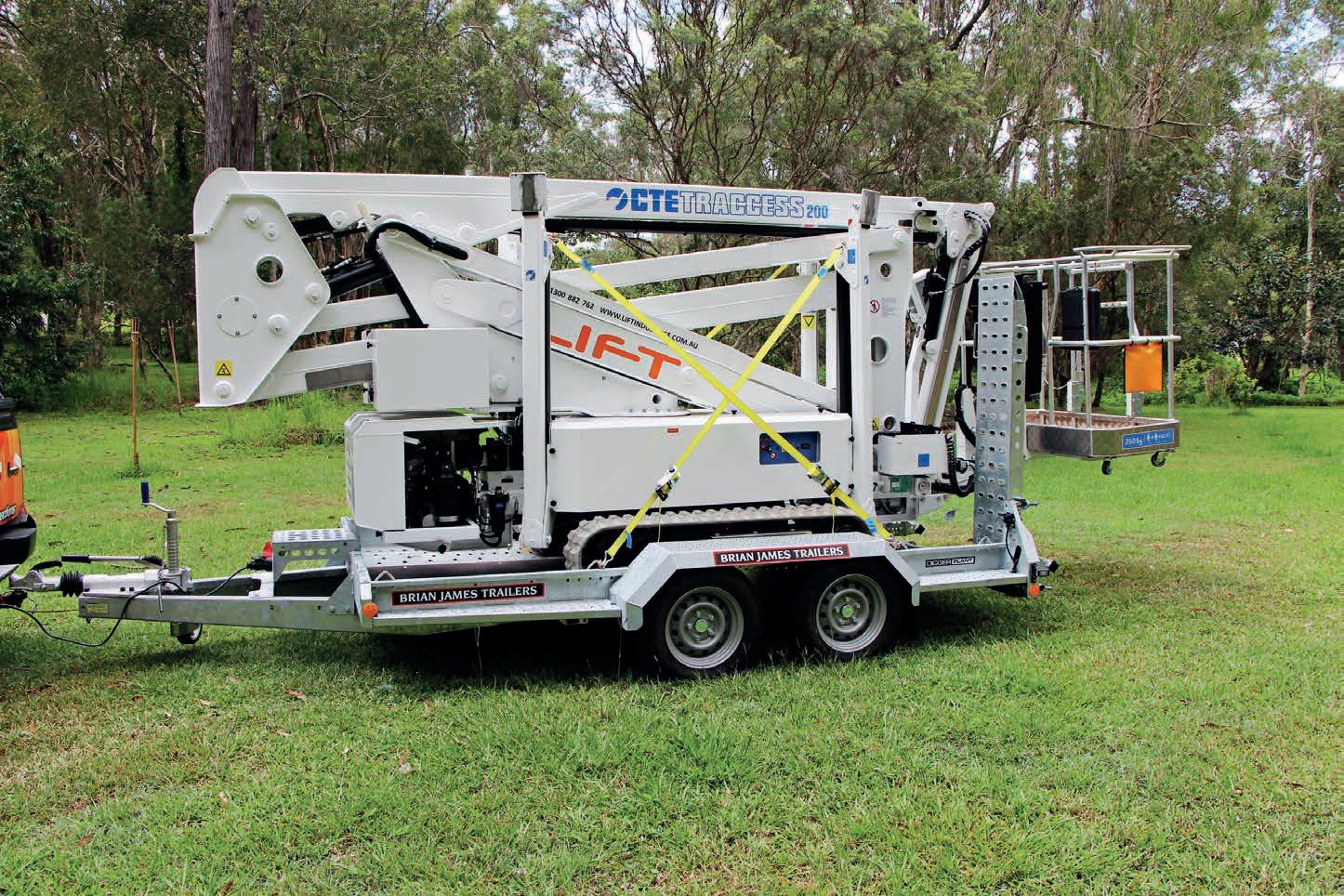
We are all looking for the most versatile of spider lifts, the machine that can offer the most and cover all your needs and more. There are many aspects to consider when deciding what makes the best in design, and this will relate to each of the height classes. Ideally, the best spider lift should be a highperformance machine in all aspects of specifications.
Following is the breakdown of the major areas to consider when overviewing spider lifts:
• This can make or break a machine’s performance
• The most practical of configurations are the Double Articulated Parallelogram or ZED-style lower-boom systems with an upper telescopic. The reason for this is that you receive more versatility and a larger work envelope. The best machines will not be weight regulated on their outreach.
• Zero tail swing
• Superior up-and-over capability
• A fuller working envelope
• The ability to vertically raise and lower, making aerial positioning more natural and up to two-and-a-half times faster than arching movements.
An actual ZED provides one single action to raise the lower booms vertically to full height, giving maximum outreach at 2m throughout the entire work envelope. This reduces set-up times and provides more utilisable work area.
A design that is not weight regulated with its outreach is preferred, as the maintenance of electronic governances
• Clean booms with all the hydraulic and electrical services housed within, to avoid hook-ups and damages
• A fly jib is essential for versatility out on the edge of the working envelope.
The more compact the machine, the better for access. The width of the machine obviously plays a factor here, and 800mm is the mark for total access versatility in this area. When it comes to gradability, one cannot compromise stability. The longer and wider the track, the better stability, especially considering spider lifts are top-heavy. 31-per-cent gradability is a good target to aim for when looking at tracked
The lift supplied by the team you trust for sales, backup and support.
An innovative tight boom design allows for better accessibility and functionality in tighter work areas. The lighter the machine, the less impact it would have in sensitive areas, both internally and externally, not to mention allowing for an easier and more cost-effective approach to transport.
A guide to the best access options on the market.
The true ZED is a more compact design that providesis a common problem among owners. A superior fixed 200kg work envelope is excellent for reliability. The Traccess offers versatility, accessibility and transportability, all rolled into one.
Combining competitively sized footprints with zero tail swing design is an essential part of versatility for those tighter work areas.
As with most machines these days, there are many electronics involved. Spiders are renowned for their issues in this area. Standards Australia’s 1418.10:2011 regulations call for the electronic protection of the machine’s stability to ensure operator safety. With smarter design we can eliminate many of the problematic electrical issues that plague these lifters, such as the outreach limiting systems, that do catch out even the technicians. Single-control stations also eliminate the problem of integrating two separate stations, in turn reducing electrical interface problems (all regulations call for the electronic protection of the machine’s stability to ensure operator safety).
The best idea here is to ‘keep it simple’, as today the only safe position to control a machine at heights is from the basket.
When looking at the performance specifications of a spider lift overall, we must determine if it carries the attributes that we need. Just selecting one aspect that is appealing would not be an active, informed choice.

One manufacturer has taken into account all of these requirements and more for lifts up to 27m.

To date, CTE is one of the world’s leading manufacturers of EWPs, with a production of more than 1000 aerial platforms per year, and with a network of dealers in more than 100 different countries.


Before CTE began to design and build in this market 16 years ago, it approached the major spider-lift sub-hirers in the UK and Europe. These companies own, operate and hire all the machines available.
With the experts help, CTE went about designing what were to be the best machines available in the highly utilised 13.5m, 17m, 20m, 23m and 27m hire classes. It went about this by using product knowledge and experience, and the result was a new design in each class to outperform all others, increased performance and reliability, and lower maintenance costs –thus the CTE Traccess range was born.
CTE Traccess is the design that has surpassed all others as the most versatile in their classes, due to their uncompromised approach to performance. They offer a 17m lift that outperforms most 18m and 19m machines, with a low tare weight and simplified electronic systems. CTE’s 20m and 23m spider can pass through a doorway, and has up to 12m of outreach. These machines fulfil all the elements discussed above that a superior spider lift requires to be the best access solution on the market up to 27m.

The Lift group can also offer a full range of steel-framed trailers to suite all CTE models, keeping weight down to below 3.5 tonnes for Lift products up to the 20m model.
Lift also provides a full range of non-insulated and insulated vehicle-mounted EWPs ranging from 10m to 60m working heights. During over 18 years of experience manufacturing these units at depots in Queensland, Lift has learned from

customers and offers packages to suit all requirements within




If you need to work at height and are looking for a quality machine to work with, call the Lift Group and talk to one of the experts to help secure the machine that fits your needs.
For more information, contact CTE’s exclusive dealer in Australia, Lift Industries, on 1800 882 762, sales@liftindustries. com.au or visit www.platformsales.com.au
Popular among arborists in Australia, the RUTHMANN Bluelift SA18HB tracked spider lift is designed for close quarters and rough terrain, and for bringing otherwise inaccessible projects into reach.

The SA18HB model is ideal for a variety of maintenance tasks thanks to its narrow width and lightweight design.
RUTHMANN Bluelift produces safe, reliable and easy-to-use elevated work platforms, and Ahern Australia is the exclusive distributor for the full line of these lifts in Australia. Suitable for a wide range of applications, the SA18HB is a flexible lift ideal for arborists, as well as maintenance, construction and industrial uses.
The ergonomic design of this versatile machine allows operators to easily move the lift into position, even in tight spaces. Proportional controls deliver precise manoeuvring to make easy work of accessing high places, and the three-section articulating boom
plus jib offers an outstanding working envelope with little to no tailswing.
The maximum working height of 17.8m and horizontal reach of 9.3m maximises production, and the 230kg
• Quickly removable aluminium basket
• Basket rotation
platform capacity can accommodate two workers for maximum efficiency. This model also has a tight turning radius for navigating narrow landscapes and aisles, and its adjustable hydraulic
• i-Performing electric pump (patented) with auto start/stop system
• 230V power outlet in basket
• Cable remote control with interactive and multi-lingual display
• Moment limiting device
• Automatic centre position of turret
• Self-stabilising system
• Automatic start and stop of engines and RPM control
• Proportional and simultaneous electro-hydraulic controls
• Proportional track drive with hydraulic braking system
• Double drive speed system with safety control
• Driving lateral slope alarm with safety stop
• Driving possible with jib boom raised (with selector)
• Interblock outriggers/booms
• Emergency push-button with engine stop
• Simple emergency lowering procedure
• Hand pump for the emergency lowering of platform
• Covers on outrigger cylinder’s piston rod, oil tank and emergency controls
• Modem connection plug for diagnosis/software upgrading in remote
• Produced according to EN280 norm and international safety regulation
chassis allows for precise positioning in any situation.
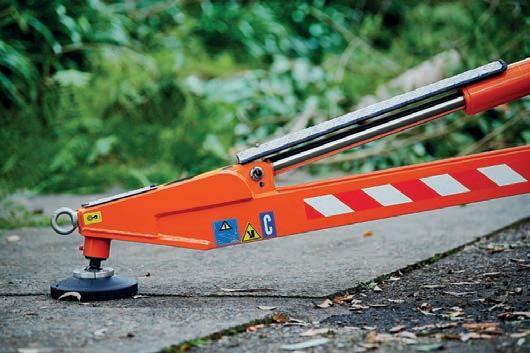

The SA18HB can be safely driven through tight areas and on uneven terrain and is capable of climbing stairs for a wider range of indoor and outdoor applications. With a gradeability of up to 28%, the self-stabilising system locks the spider lift into place for safe work at height.
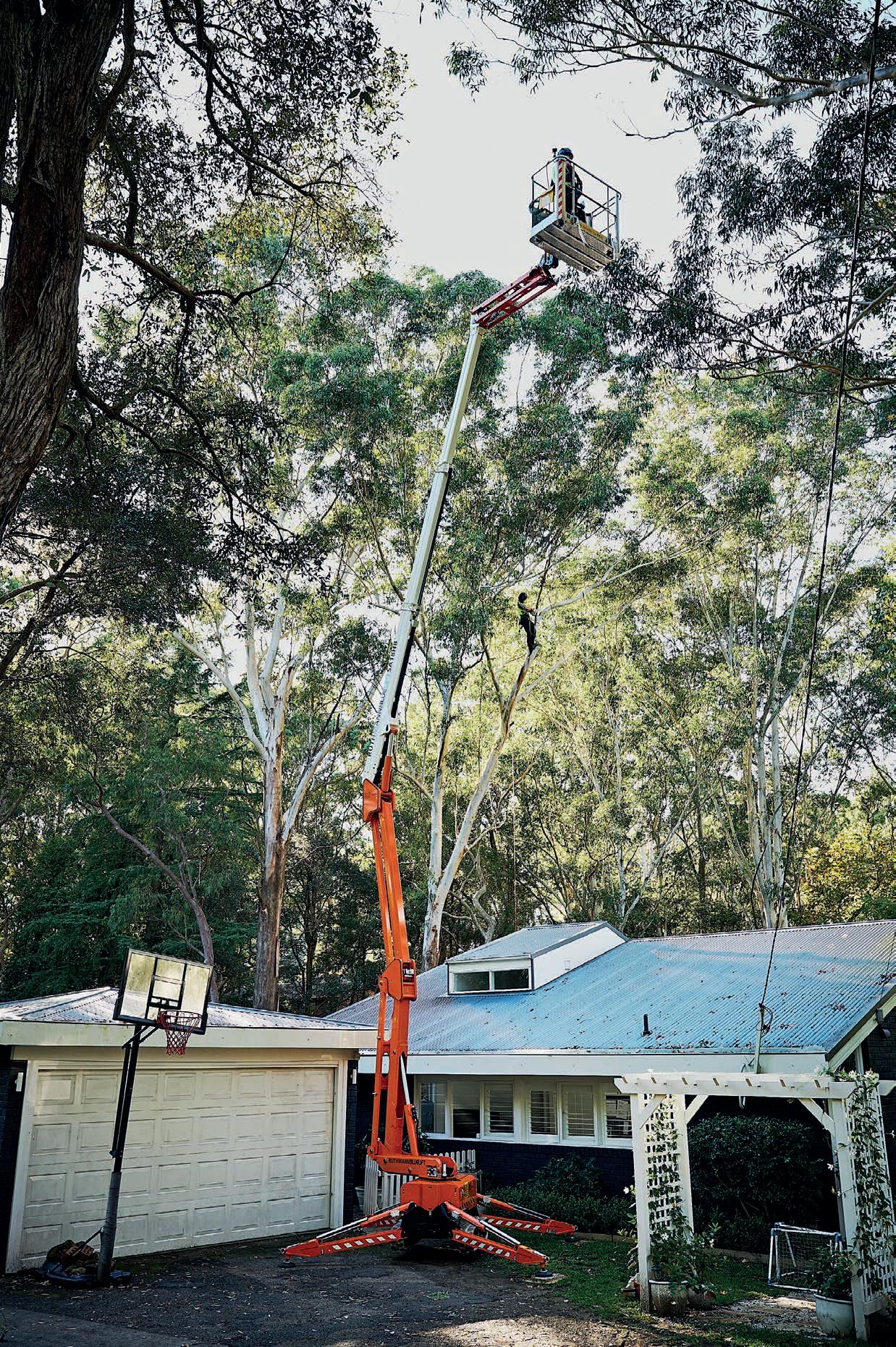
For added protection, interlocking outriggers help the spider lift maintain balance on all terrain, and a selfstabilising system locks the spider lift into place for safe work at height. Hydraulically operated articulating outriggers can be set at individual heights, and optional non-marking rubber treads leave no trace on finished floors. Compact and narrow with an overall weight of 2200kg, the Bluelift SA18HB can be easily transported between jobs.
For more information call the Ahern Australia team on 1300 900 700 or visit ahernaustralia.com.au.
With labour shortages, stable demand, good supply and rising prices, 2023 is a great time to invest in firewood production – particularly for arbour businesses which can benefit from an extra revenue stream during the quiet periods.
Designed and made in in Australia, Whitlands Engineering has built a reputation over almost three decades for machinery that is practical, efficient and built to last. The Superaxe range includes three models, all featuring a vertical sliding blade, double-handed control, ergonomic design and twoyear warranty. The Rex range is suited to more commercial operations and includes a range of log saws and firewood processors.
All machinery is built to order in Australia in the Whitlands Engineering regional Victorian workshop.
On the back of the success of these machines, over the years, the range of wood-handling options has expanded.

The 3m fold-out outfeed elevator was the first innovation to be fitted to the Superaxe 3150 or 4150 – enabling stockpiling or truck loading without any extra labour. This, when combined with an infeed hopper, can pay for itself in labour savings within months.

The elevator range now includes three
free-standing elevator options – 6m, 9.5m or 13m, or 16m long. These larger units can be powered with a 6hp Honda engine, making them completely selfcontained. The other options for these elevators include a Sargent Stripe belt for better grip and lift and/or a griddle tray to sort out fines and rubbish.
The trommel is designed as an add on to a bulk-processing system, cleaning the wood in the last step before packaging for bulk retail sale.
The next level up is a wood-cleaning trommel.
The trommel is designed as an add on to a bulk-processing system, cleaning the wood in the last step before packaging for bulk retail sale.
The Trommel will efficiently remove all fines (dirt, gravel, wood chips and splinters) through the fine screen and most of the kindling and smaller pieces of wood through the coarse screen. For wood yards this means the wood is cleaner, more saleable and results in more accurate weight measurement. In a full system, with a constantly loaded infeed hopper, the capacity of this machine is estimated in excess of 60m³ per hour.

Talk to the office team at Whitlands Engineering about how they can help your business become more efficient and profitable – free call 1800 702 701 or email superaxe@superaxe.com.au
Tree Radar Australia uses a ground penetrating Radar Unit to provide the only, completely non-invasive method of tree decay detection and tree root detection available in Australia.
Tree Decay is a severe problem which can put all the structure around a tree at risk. With Tree Radar Units™ decay detection, Tree Radar can scan for decay in any tree regardless of its height. The Tree Radar unit can give an accurate read out of the severity of decay in a tree without having to penetrate the Tree’s surface.
Tree Radar Unit™ can detect and establish the root proliferation of a tree, this allows the arborist to inform developers of any structural or instability issues without the need for drilling or digging.

Aerial Access Australia would like to start by welcoming its valued team members, families, clients and industry providers to the new year, and wish you all a safe, productive and innovative 2023.
This year, the plan is to improve the supply of Versalift genuine parts nationwide, introduce more innovative electrical technology and maintain stock of new EWPs for immediate availability.
Over the past 18 months, both internal sources and industry counterparts have highlighted the demand for improved availability of parts Australia-wide. Exacerbated by freight issues, the slow supply of spare parts has severely impacted businesses all across Australia.
Aerial Access recognises the need to import more stock for distribution to minimise operational downtime when
units require servicing, repairs and rebuilds.
This year is kicking off full steam ahead for the Aerial Access team with its commitment to supply all Versalift Australia users with a growing range of genuine Versalift spare parts.
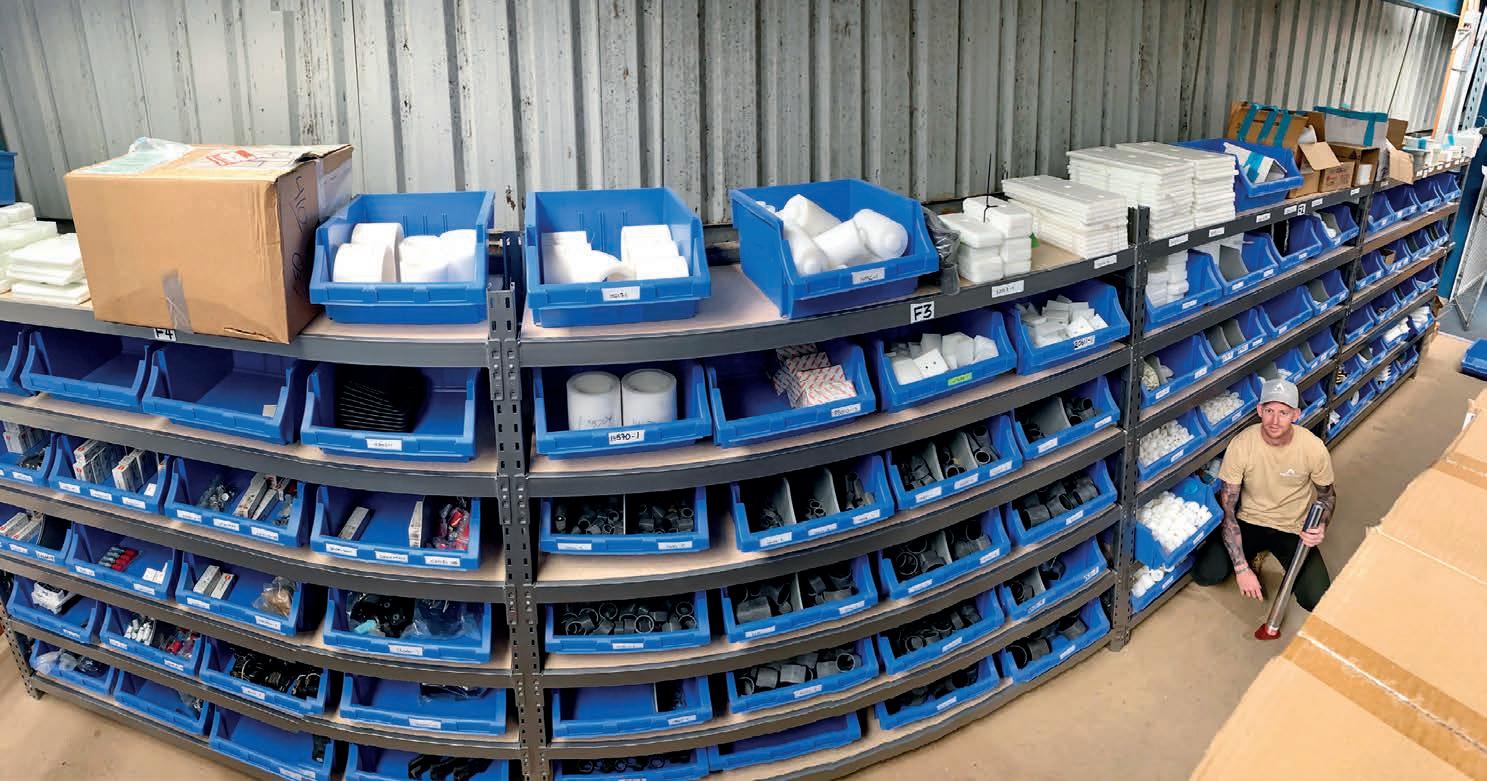

Aerial Access is now Australia’s largest spare-parts agent for Versalift products and leading stockist of a wide range of Versalift Insulated Elevated Work Platforms.
Bayswater, Victoria, is the new home of a fully tailored spare-parts facility housing a massive range of parts that will expand well into the future.
Aerial Access has been working on several hybrid/electric units which are
now in the final stages of completion. Builds Manager Chris Sanderson said the project has been based on feedback from the front line.
“We chose to build the well-known little workhorse of the TEL29-EIH strapped together with a Hino 916 300 Series hybrid cab chassis to start off with as it will offer industry users an optimal little set up for the urban environment. Its small footprint is great for tight access areas. It has an 8.86m vertical reach and a 7.14m horizontal reach next to a silent operational work mode, so it’ll travel to where you need and get you home without the concerns of running your battery flat.”
Aerial Access welcomes enquiries from industry counterparts wanting to explore this technology, with demonstrations available for those interested in learning more.

Aerial Access currently has several turnkey Insulated EWPs available for immediate delivery, in conjunction with a massive array of units in production. If you are considering a new machine, jump on the phone and lock away a build before they all sell out.
Aerial Access has been a major supplier of elevated work platforms (EWPs) in Australia for over 25 years. The company’s Insulated EWPs have been specifically designed for the utility, construction, electricity and vegetation industries, and the robust construction of every EWP has been designed for hard use, long life and easy maintenance. All units come with a 12-month warranty with an extended warranty option of up to two years.
Aerial Access provides a dedicated 1300 phone line for national back-up service agents located throughout Australia.
With an ever-increasing footprint, new facilities under development and a growing internal fleet hire division of over 200 insulated EWPs, the team at Aerial Access is always ready to discuss light-vehicle, heavy-vehicle, specializedplant and auto-electrician employment opportunities in a workshop near you.







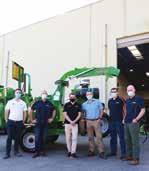
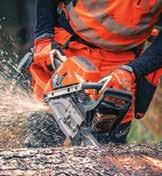

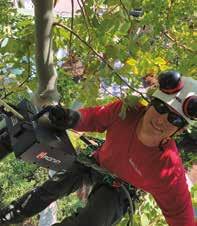



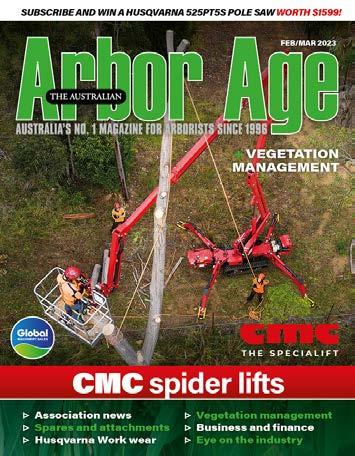




On top of following all commercial transport operation requirements and DOT guidelines, you’ll also want to make sure you’re performing and documenting pre-trip and posttrip inspections on your wood chipper.

Important points:
• Keep all components in good condition – tyres, brakes, suspension
• Check wiring, connections and lighting for proper operation prior to use
• Make sure the inspections and results are documented and report any maintenance issues
• Ensure repairs are made by qualified people prior to use.
A machine’s operator’s and maintenance manuals instruct how to properly operate and maintain that machine. They detail the unique features of the chipper and its operation. Operators should familiarise themselves with the manuals.
Important points:
• Using the machine safely starts with understanding the manual
• Manuals are critical to understanding the safe and correct use of the machine
• Following the proper instructions will improve the performance of the machine.

Operators should know how to properly shut down a machine and follow lockout and tag-out procedures.
• Remove the key from the brush chipper before attempting to clear a clogged chip chute or an infeed jam
• Never attempt to service any part of a machine while it’s running
• Never open the drum or disc access without locking out the machine
• Only trained and authorised individuals should carry out any job outside basic field maintenance.

Never allow ropes or lines in a wood chipper work area. To help avoid hazards, keep the jobsite away from the wood chipper work area.
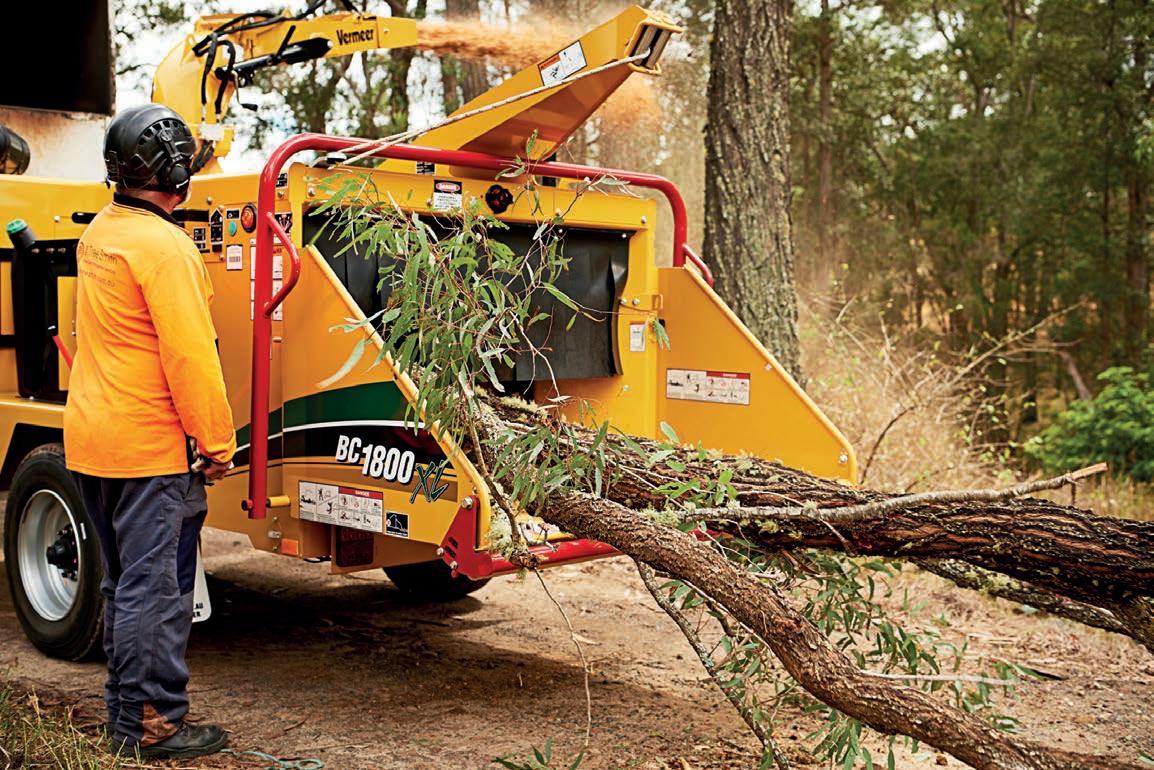
• Develop a plan
• Never allow ropes or climbing lines around a chipper work area. They can get tangled and pulled into the chipper
• Keep the jobsite separate from the brush chipper work area
• Do not chip in a drop zone when a climber or lift is aloft.

Operators should know how to operate the winch controls and what each control does.
• Know how to properly use the winch according to the manufacturer’s instructions
• Always have the chipper attached to the tow vehicle when using the winch

• Ensure the winch line doesn’t tangle with material being fed into the chipper


• Always store the winch line on its proper storage hook or interlock
• Once material is engaged, the feeding process must be stopped and the winch retracted and stowed before proceeding
• Store any line and accessories properly
• Never permanently attach any chain or hook to the end of the winch line
• Never carry a winch line with a chain or heavy object
• Never wrap any part of the winch line around a hand or arm while carrying it
• Always use the proper manufacturer’s line for the winch
• Never use rope with elastic properties.
Land clearing made easy.
Land clearing is a complex process requiring heavy machinery and precision work to remove trees and other vegetation. Doing the job right requires experienced professionals who understand the delicate balance between land clearing, preserving native species and habitats, and protecting the environment from unchecked deforestation. Enter Bandit Horizontal Grinders—an ideal solution for land-clearing projects of any size.
Bandit horizontal grinders can quickly and effectively clear large pieces of land for commercial estates, residential
projects, road work, track work, civil projects, and more. With Caterpillar engines across the range, producing up to 1200 horsepower on large models, these machines are powerful enough to handle any woody or natural vegetation that needs to be cleared to make way for new projects. The horizontal grinder range can quickly grind up anything from palm and dirty mulch, through stumps, tree roots and on to construction waste.
The Bandit horizontal grinder offers numerous benefits for land-clearing projects.

First, this machine is incredibly fast;
it can process up to 500 cubic yards per hour without sacrificing quality or efficiency. Additionally, this grinder produces very little waste material; you don’t have to bother about disposing of excess debris after your project is finished.
In addition, these machines offer several other advantages over traditional tree removal or land-clearing methods. They are incredibly efficient and can process up to 70 tons of material per hour, meaning they can get the job done in less time than manual labour or other machinery. They require less energy and water than manual techniques could ever hope to achieve. Their powerful engines
Land-clearing contractors use horizontal grinders to deal with a range of native vegetation, green waste and woody debris.

create minimal emissions compared with older models of tree removers or land-clearing tools – making them an environmentally friendly choice for your project! In addition, horizontal grinders typically produce less dust and debris than other land-clearing methods.


Bandit horizontal grinders also come equipped with a range of features designed to enhance operator safety while increasing their efficiency on the job site—including noise-reduction technology and vibration dampening systems which reduce strain on operators and machines alike during those long hours spent working on landclearing projects.
A horizontal grinder uses a series of rotating blades to grind up the material into small pieces.
Various tooth and screen options allow anything to be processed, and a range in size of final products to be produced.
This process is often used to prepare land for construction or development projects.
Horizontal grinders are also frequently used to clear land for farming or ranching purposes. In addition to their land-clearing applications, horizontal grinders can also be used for recycling applications.
Horizontal grinders are versatile apparatuses that can be used for various applications. Land-clearing contractors use them to grind up a range of native vegetation, green waste and woody debris, which can then be used as mulch or composted. Agricultural businesses use them to grind up crop residues, like corn stalks and wheat straw. Horizontal grinders can also process recycling materials like paper and cardboard. Whatever your material-grinding needs are, a horizontal grinder is likely up to the task.
For more info visit banditchippers.com.au or email manish@eeagroup.com.au.
With Intelligent Boom Control.
John Deere is pleased to announce its latest operator assistance control feature, Intelligent Boom Control (IBC), for the 900 MH-Series Tracked Harvester.
The development of this model is a result of global collaboration between the John Deere Wheeled Cut-to-Length and Full-Tree Forestry teams, aiming to

implement IBC’s field-proven technology into the MH-Series of tracked harvesters.
With IBC, operators no longer need to control each independent boom function separately. One joystick moves the boom tip horizontally, while a second guides it vertically, for faster cycle times and more precise control. IBC’s smooth and
fluid motion actively dampens functional change of directions, protecting boom structures and increasing wear life. IBC also automatically controls swing speed based on the overall position of the attachment.
“The continuous product development, new features and the updating of
systems and solutions are integral parts of John Deere’s way of operating,” said Jim O’Halloran, product marketing manager, John Deere. “Intelligent Boom Control is an example of an important operator-assistance feature that we will continue to evolve throughout full tree forestry. Developing solutions for our customers’ needs is our number-one priority, and investing in innovation, like IBC, is an example that helps the overall productivity and profitability for the whole machine life cycle.”
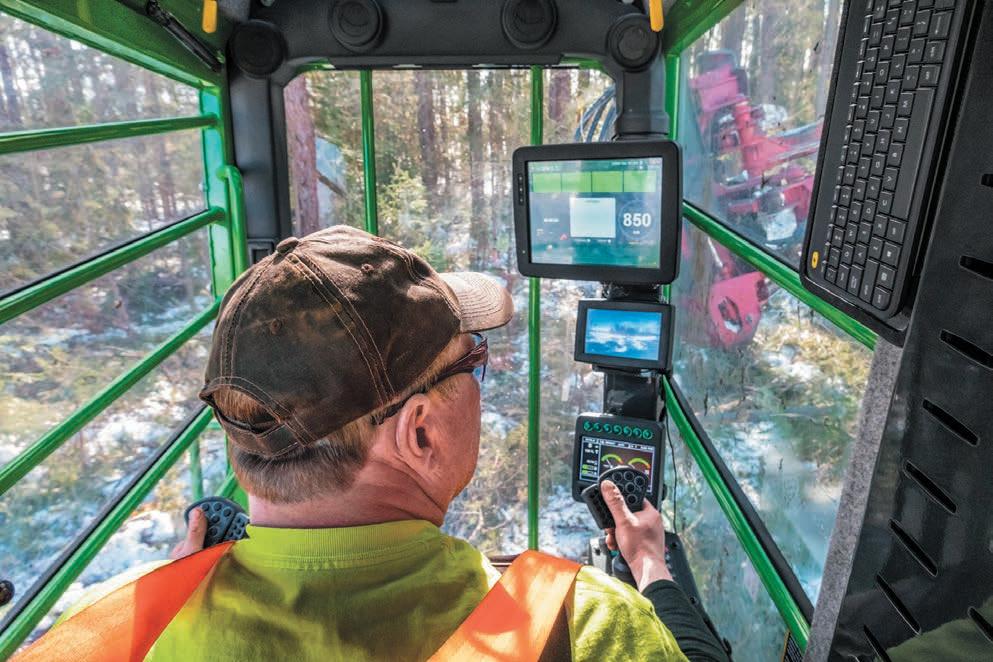

About Deere


Deere & Company (www.JohnDeere.com) is a global leader in the delivery of agricultural, construction, and forestry equipment. The company helps customers push the boundaries of what’s possible in ways that are more productive and sustainable to help life leap forward. John Deere’s technology-enabled products, including John Deere Autonomous 8R Tractor, See & Spray and E-Power Backhoe, are just some of the ways John Deere helps meet the world’s increasing need for food, shelter, and infrastructure. Deere & Company also provides financial services through John Deere Financial.
• Improved productivity, compared to the same machine without IBC, is another benefit for customers. IBC allows the operator to focus on controlling the attachment, helping improve efficiency. The controls used for reaching and securing trees for harvest intuitively mirror how the equipment might function if it were the operator’s arm.
• IBC is now available on the 953MH and 959MH.
For more information, please scan the QR code above, visit www.deere.com.au/en/forestry/ibc/ or contact your local dealer.

Careful consideration needs to be given to the scope of your business activities and the type (or types) of coverage required.
We all know arborists are engaged to provide reports to a variety of clients such as schools, government departments, businesses and consumers. These clients rely on these reports to make important decisions about protecting property, equipment and people.

This reliance exposes arborists and landscape architects to various risks which can contribute to financial loss, personal injury and property damage suffered by third parties.
Insurance cover is essential. The right insurance cover is critical
When protecting your business against risks, careful consideration needs to be given to the scope of your business activity and the type (or types) of coverage that are required. It may sound cliché, but there is limitless truth in the saying, ‘Not all policies are the same,’ and ‘cheap insurance’ can cost you a lot more in the unfortunate event that you need to claim and are not covered by the policy.
• Public and Products Liability: provides cover for any injury or damage to third parties arising out of your business. Does not cover financial loss suffered by a third party.
• Professional Indemnity: provides cover for financial loss suffered by a third party who has relied on your professional services, and in the event it turns out to be wrong. It doesn’t cover personal injury or damage to property.
Austbrokers SPT has negotiated with two leading Australian insurers to provide coverage which considers both scenarios in a cost-effective package to the industry.
The level of cover under such policies is often determined by a third party, usually the principal contracting party. An example is when you are working around power lines, a public liability limit of $50,000,000 to any one claim is currently required.
A serious incident which occurs now may not be heard by the courts for several years. The Public Liability policy which pays the claim is the one in place when the incident occurs but the policy limit needs to be adequate for the claim when it is settled in the future.
For Professional Indemnity policies, the level of cover is not so clear and can be determined by a number of factors, such as budget and scale of the project, the client and complexity or uniqueness of the project. These policies operate to pay the claim when you first become aware of the incident, even though the work was done in the past.
The best way to manage the risks you have is to follow your policies and procedures when doing the work, and to work to the brief you have been provided.
• A broker works for you and understands the claims process, making it faster, more efficient and less worrying for you
• They advise you if and when you
need to update or change your insurance policy
• They are your representative and will help you through the challenging times as well – like when you need to make a claim
• Your broker is the link between you and the insurance company to ensure you receive everything you are entitled to when making a claim
• The insurance broker acts as the primary contact between you and the insurer, because insurers have existing relationships with brokers too – they speak the same language, and
• A broker understands the complexities of your policy fine print and is familiar with the claims process. You don’t have to stress over the tricky bits!
Austbrokers SPT is passionate about the horticultural industry, and it is this passion that continues to drive it to exceed its clients’ expectations.
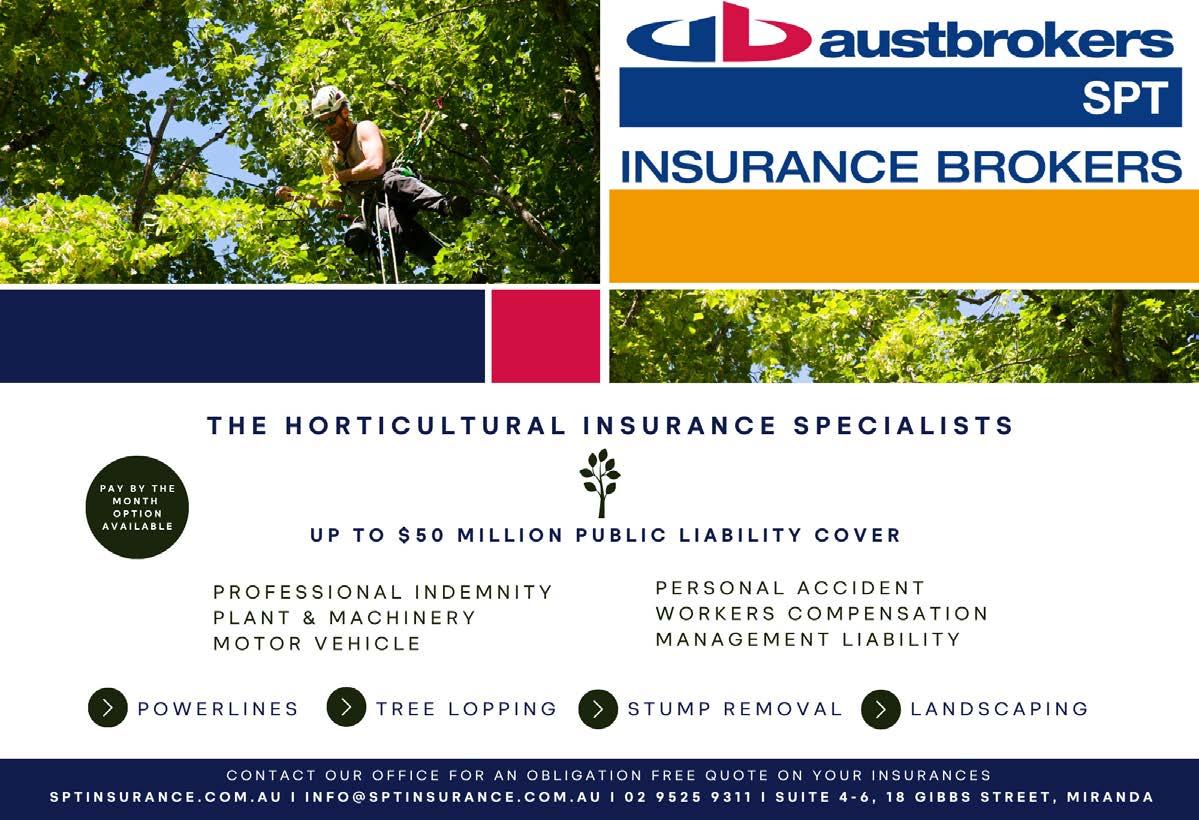

9525 9311
email info@sptinsurance.com.au.
•
•
Hiring a contractor or sub-contractor is often appealing to time-poor, cash-strapped small-business owners. One reason is they take care of their own insurance (as opposed to the business owner having to provide coverage for them, as is the case with employees). But what if things aren’t quite that straightforward?
they are negligent in carrying out that responsibility and exercising control. If they are negligent, you may be deemed to be responsible for some of the property damage or bodily injury caused by the subcontractor or contractor.
Ithe subcontractors you use in your business? The answer is NO!
Insurers do not include subcontractors under liability-insurance policies. If they did, the insurer then accepts the liability for all subcontractor’s work. The subcontractor could potentially cause an incident which results in property damage or an injury to a member of the public, and the subsequent insurance claim would be held against you, because they are an insured party under your policy.
Imagine the following scenario: You subcontract a tree lopper to cut down a tree and he damages the roof of the house in the process. What was a $1000 job results in $100,000 in damage. It will then be for the insurer to decide whether the policy will respond to this incident or deny liability. It may leave you responsible to pay costs for damages for work of you knew nothing about – costs which could be in the tens of thousands of dollars or higher, depending on the incident.
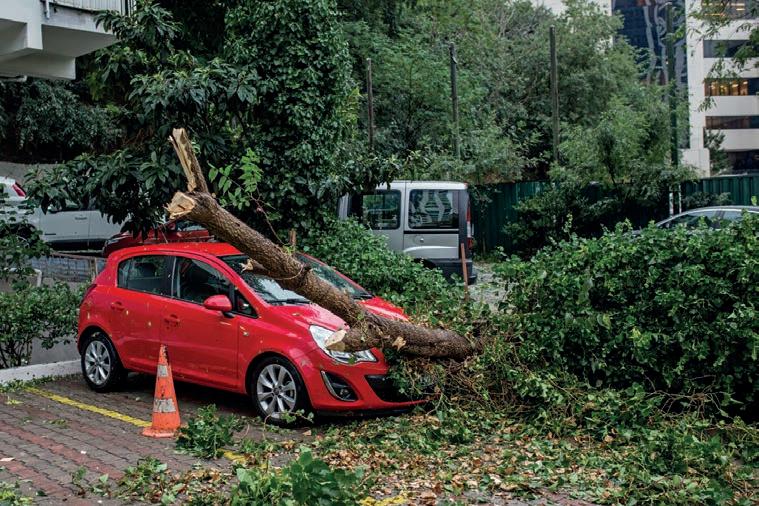
It’s crucial for small businesses to ensure all their contractors and sub-contractors have appropriate contractors’ insurance in place.
But what policy?
That depends on the job. But a humble suburban tradesman will often have public and products liability,
Is your Insurance Policy covering the subcontractors you use? The answer is NO!
compensation insurance. Err on the side of caution when checking any contractors or sub-contractors you use show you all the relevant policies to provide proof, so you are unlikely to be left on the hook if they, or one of their team, starts a fire or falls over and breaks a leg.
The best way to ensure a subcontractor has their own cover in place is to obtain a Certificate of Currency from them. A Certificate of Currency will provide the information on their policy and can give reassurance they have cover and you may not have significant out-of-pocket expenses.
Your liability policy should also include an extension for Vicarious Liability.
Vicarious Liabilities can arise in situations where you are responsible for a third party (eg. the subcontractor or contractor who is working for you), and
Vicarious Liability covers this exposure, so it’s important to check your policy includes this extension so you are not left out of pocket or with a damaged reputation.
Some key points to remember when dealing with subcontractors:
• Ensure all contractors are aware of their responsibilities and understand house rules;
• Ensure records are kept up to date detailing contractors’ attendance at principal’s induction program;
• Confirm all subcontractors or contractors have their own adequate insurance cover in place that provides indemnity for you by naming you as their contract principal;
• Check the cover a subcontractor has in place includes sums insured that match your insurance cover, and has no clauses that will pass the liability on to you, or exclusions that relate to the work you are performing; and

• Obtain and keep on file a copy of each subcontractor’s Certificate of Currency and diarise to ensure an updated certificate is obtained each year or for when new work is performed.
This article provides information rather than financial product or other advice. The content of this article, including any information contained in it, has been prepared without taking into account your objectives, financial situation or needs. For more information or questions on subcontractors’ cover or your own policy, please contact Fitzpatrick & Co. Insurance Brokers on 03 8544 1636 or email: insure@fitzpatrick.com.au or visit the website at fitzpatrick.com.au Fitzpatrick & Co has specialised in the horticulture and arboriculture industry for over 30 years providing assistance and financial support to companies, associations and events. We are there when your industry needs you.


Customer satisfaction is our #1 goal. Oliver from O.S. Trees in Bathurst is a testament to that. Oliver has been a proud Bandit customer for over 10 years, with a range of chippers starting from a 6-inch right through to a 21-inch. Oliver needed an even larger chipper in his fleet, and the new Bandit 20XP HD was the perfect fit.“These bigger machines are more cost-effective for the client,” says Oliver. “They’re getting through more work. Production-wise, and with the remote eliminating that extra man on the ground.” Having a service team backing him up is an important part in keeping Oliver’s business on track. “The support from Terry for parts and service is all good and positive. And I think Bandit will do well with the new EEA Group branch in Orange” says Oliver. Customers like Oliver are the reason why we love what we do at Bandit. Our goal is simple. To ensure you have an outstanding experience with your Bandit machine every day. Welcome to the Bandit Family.

